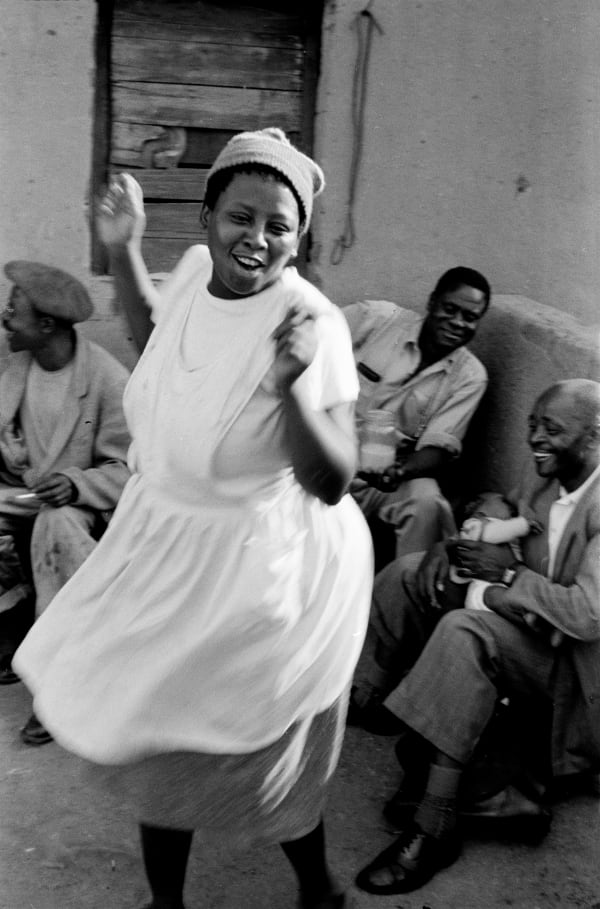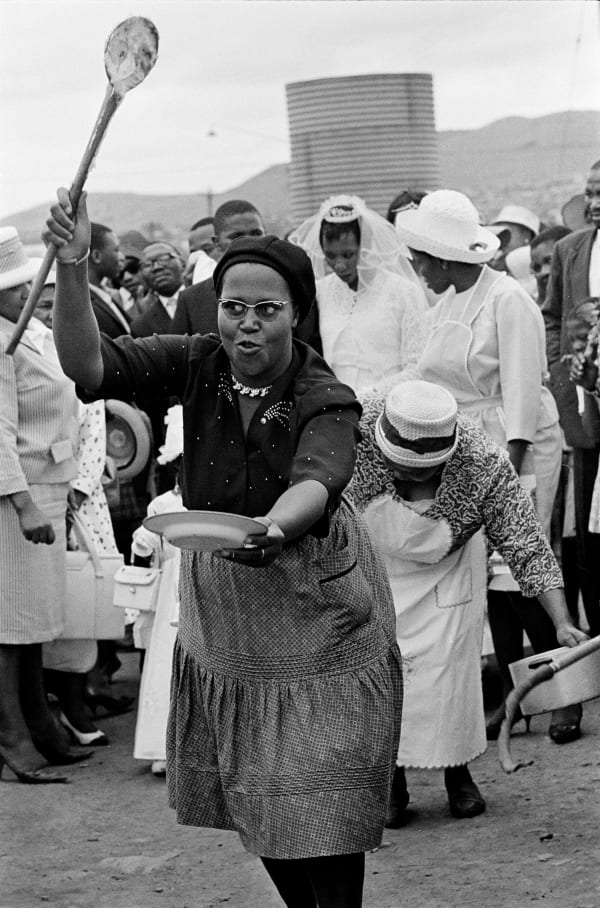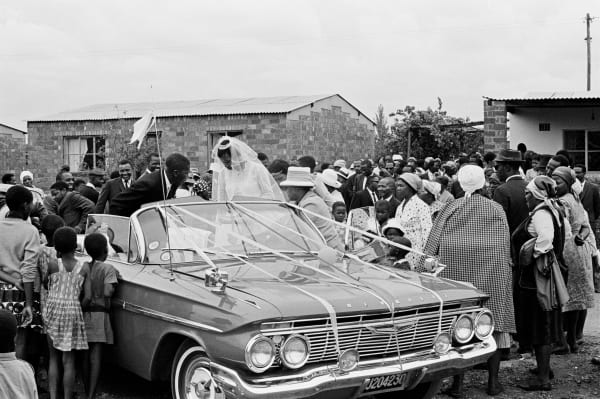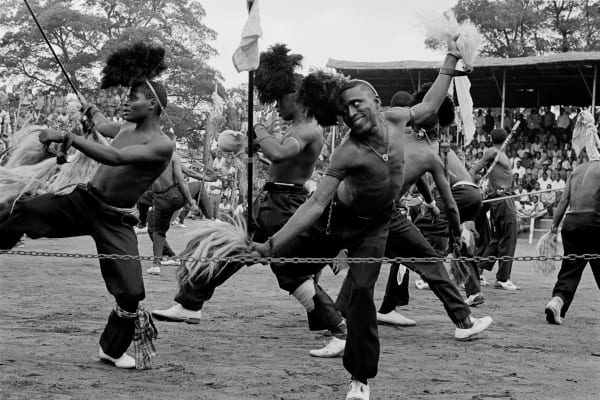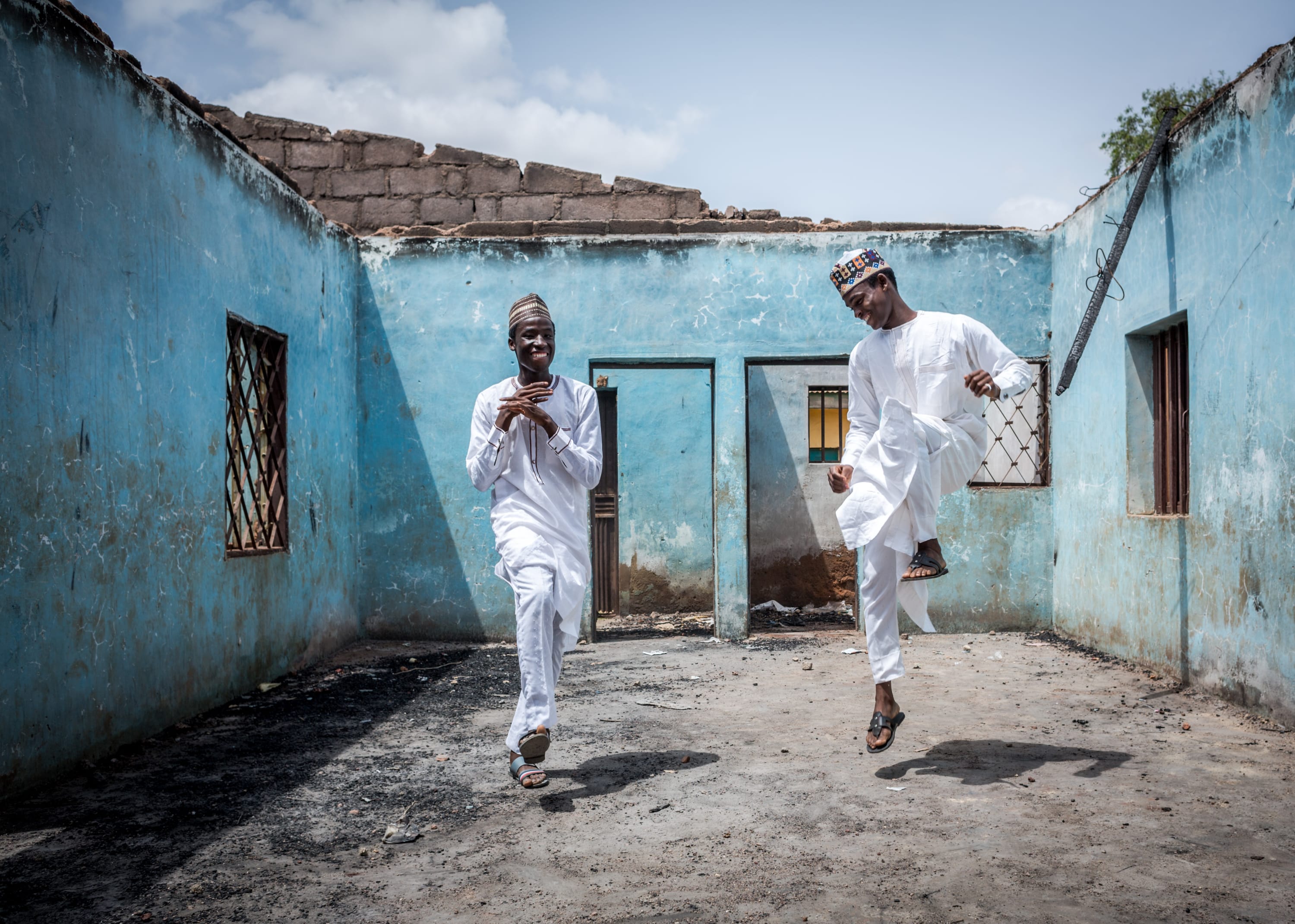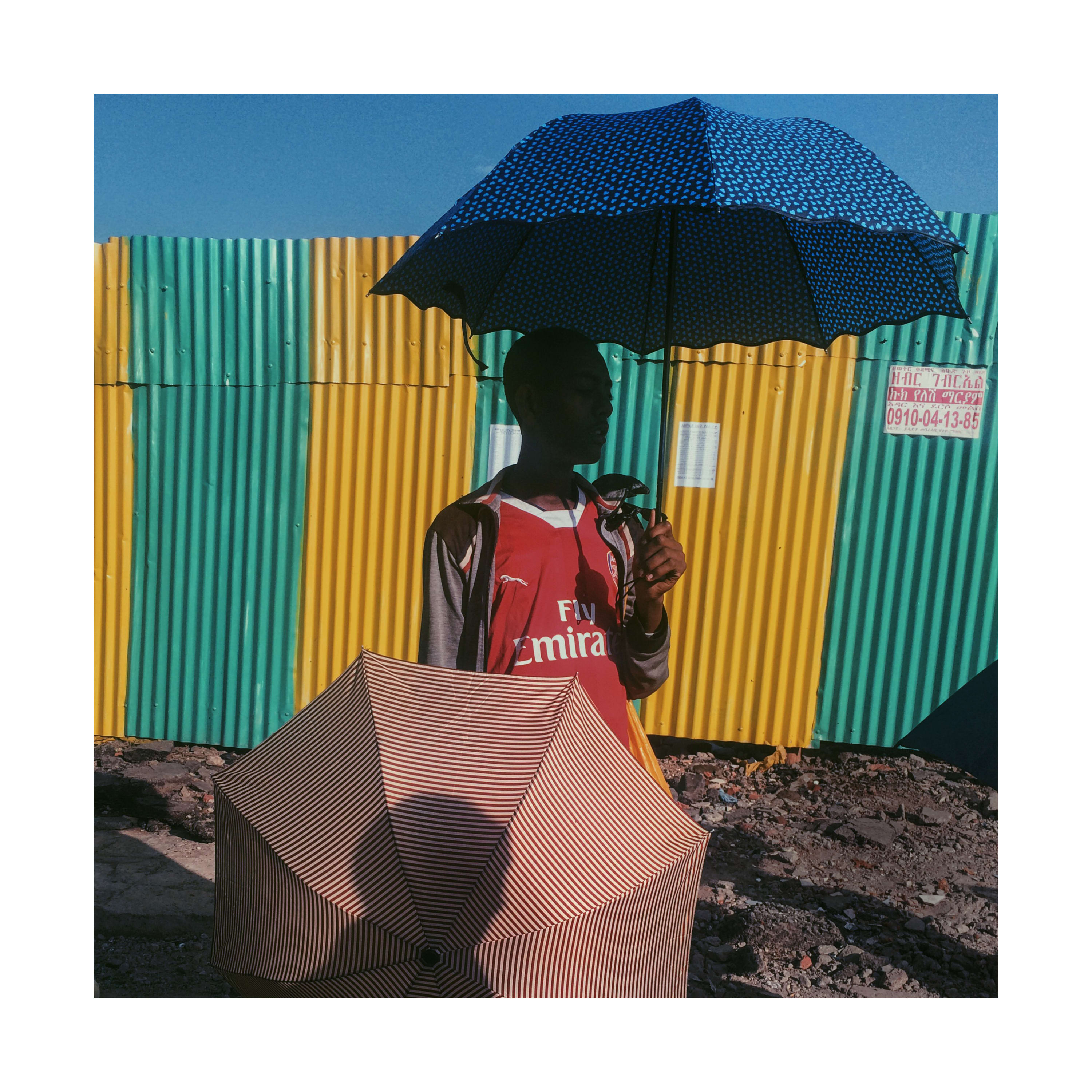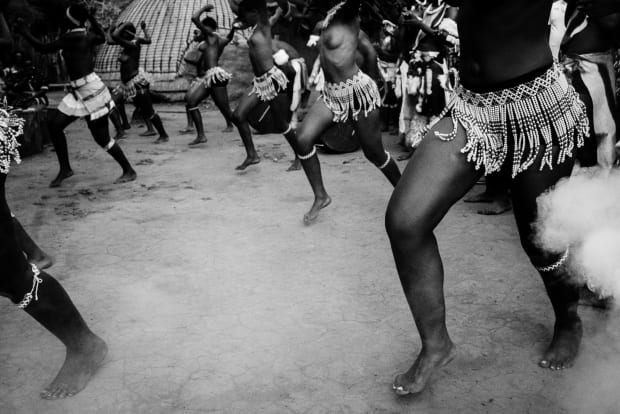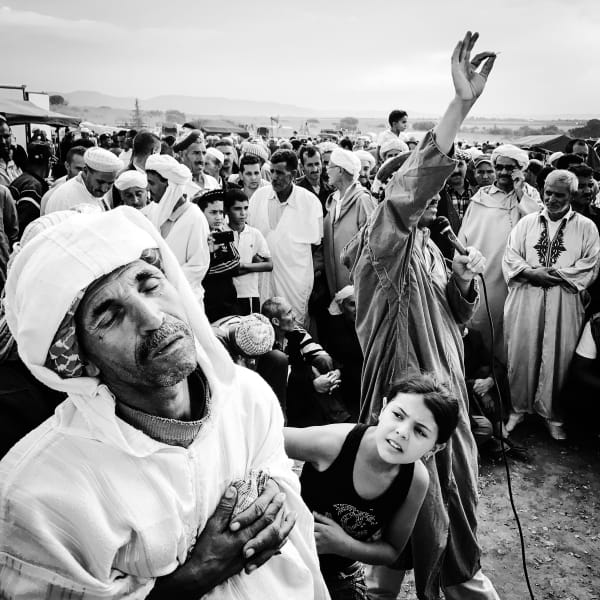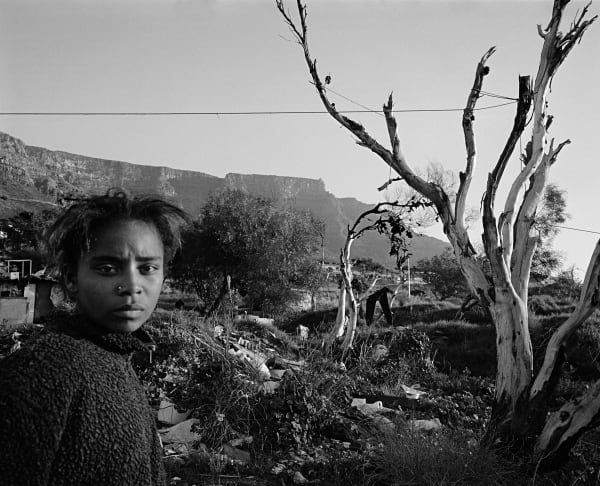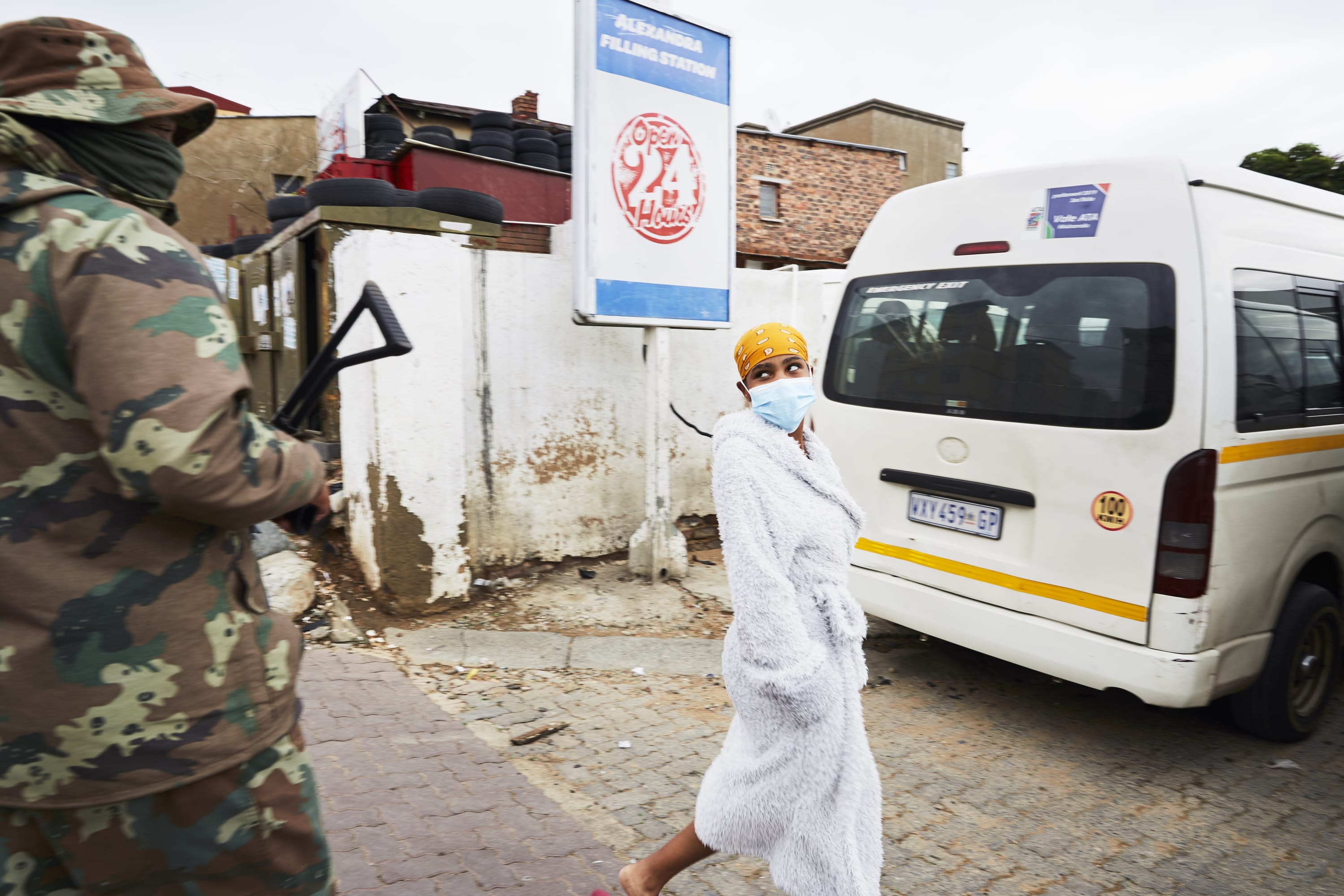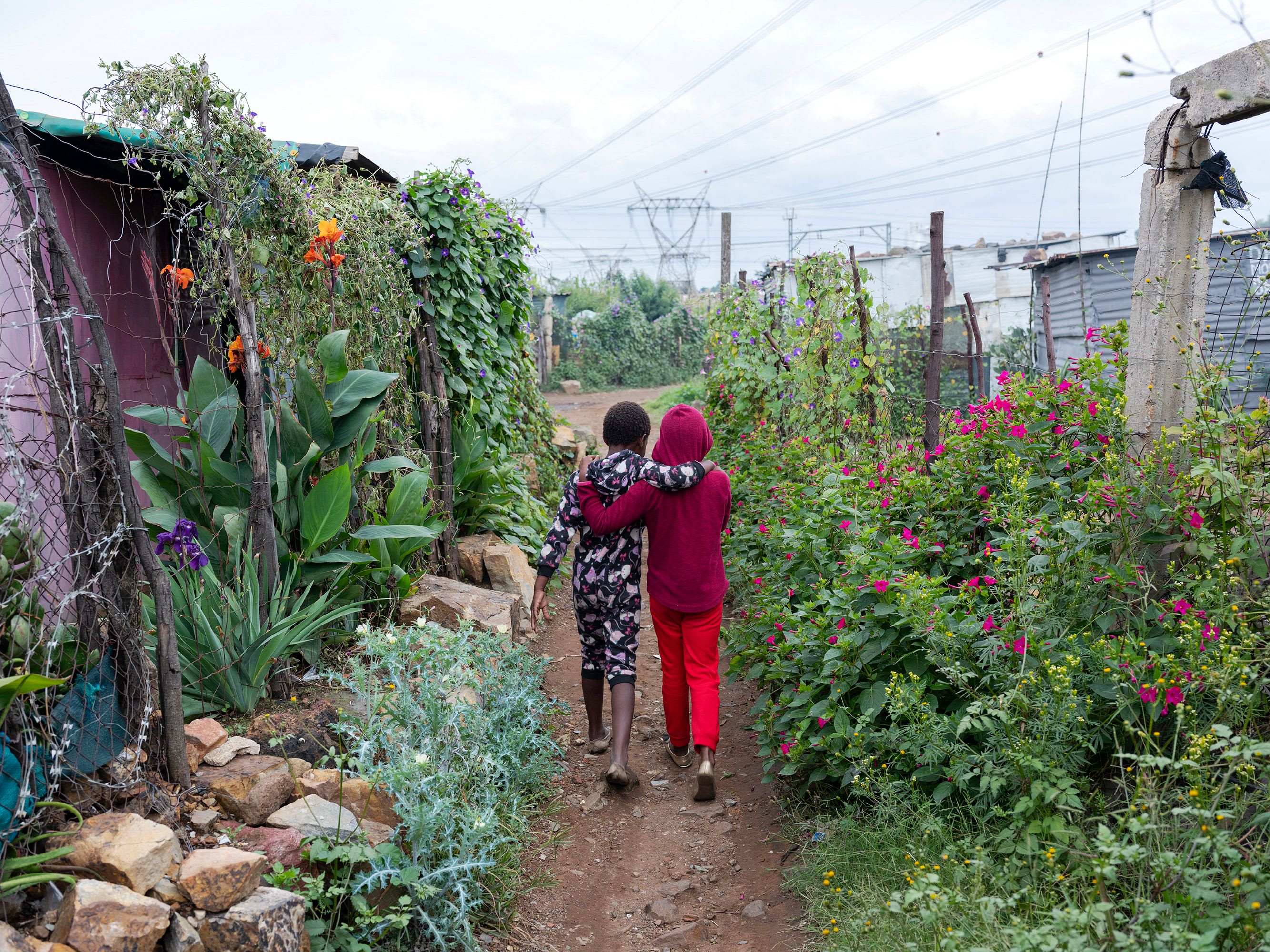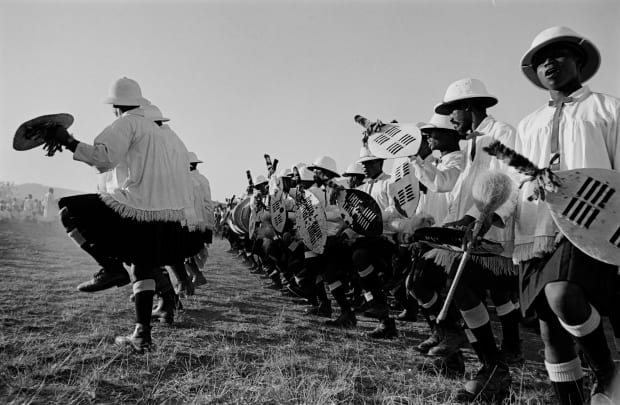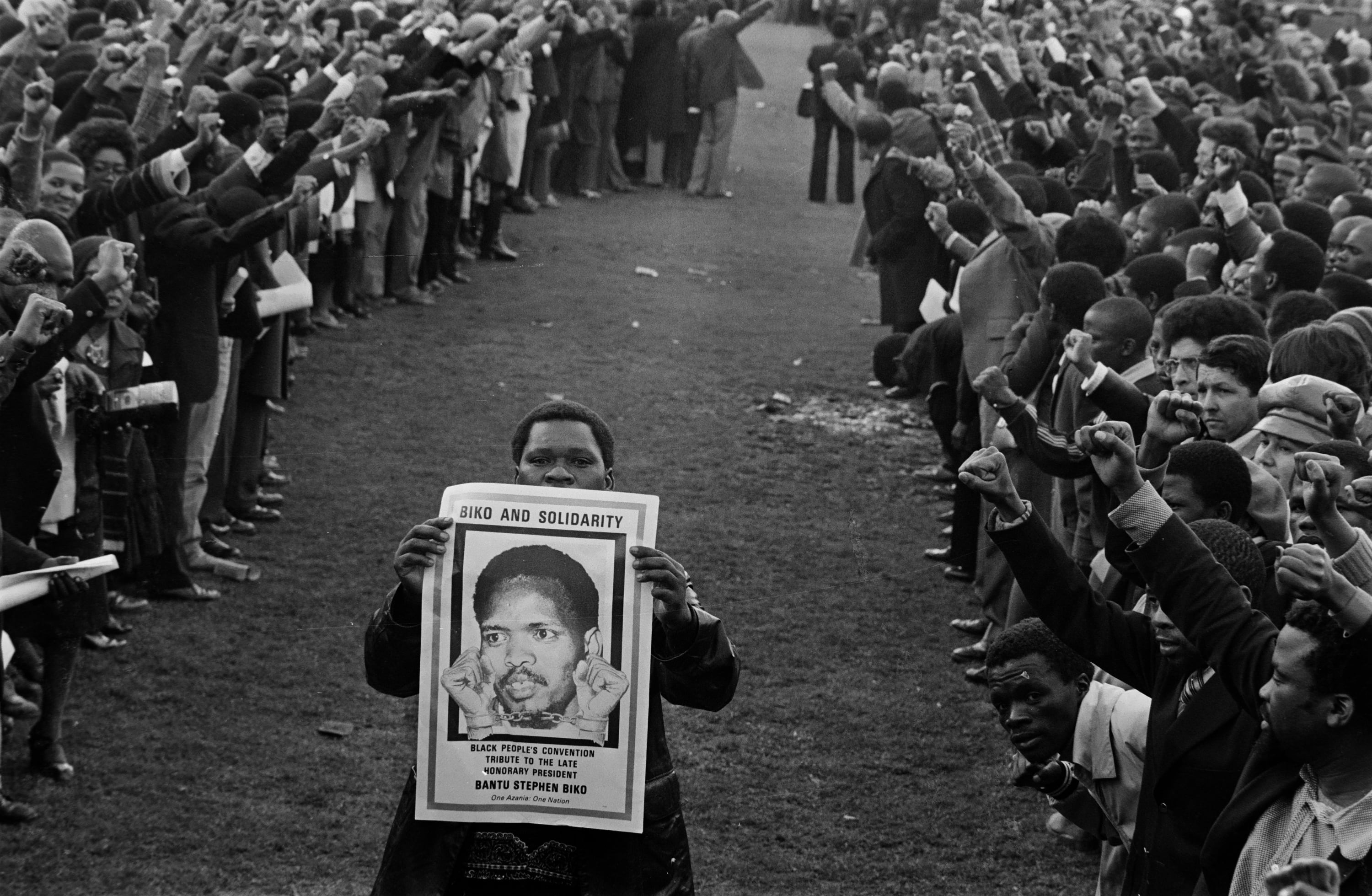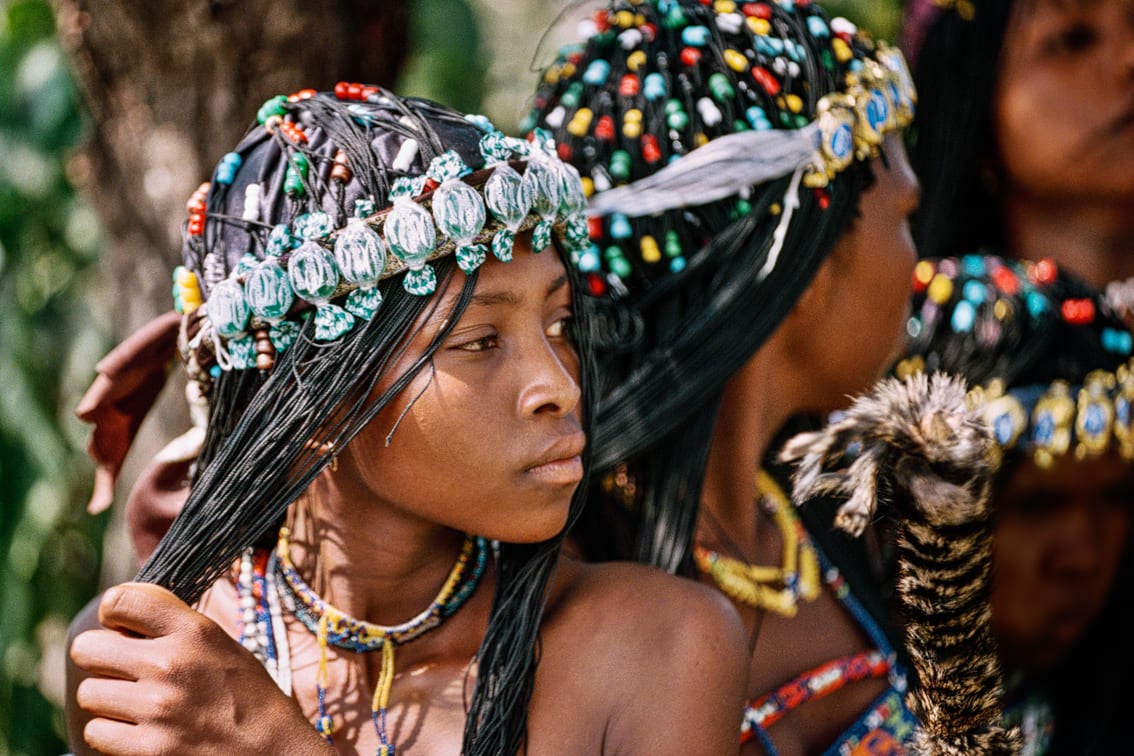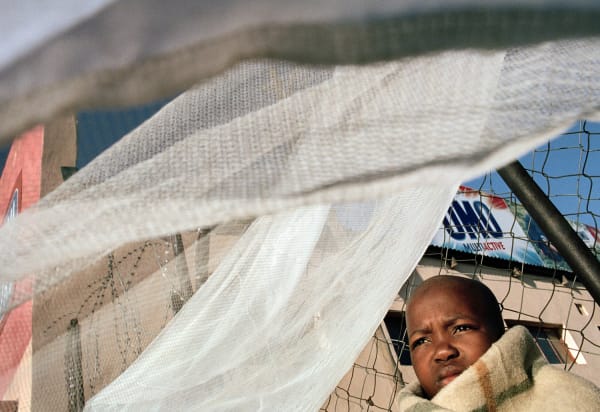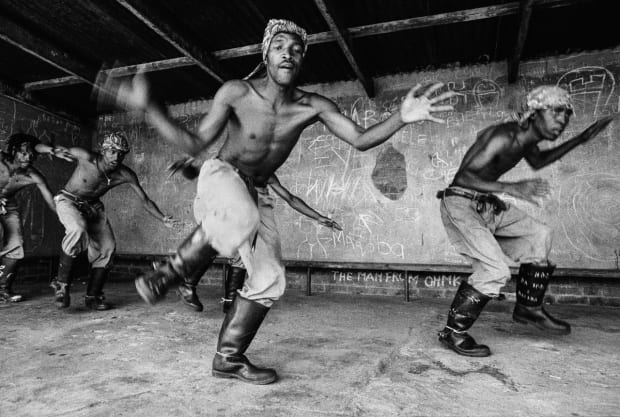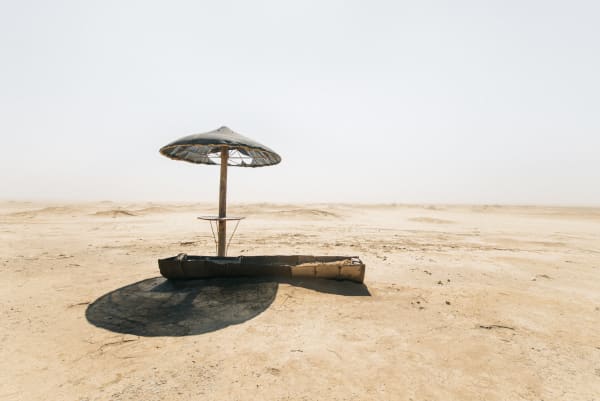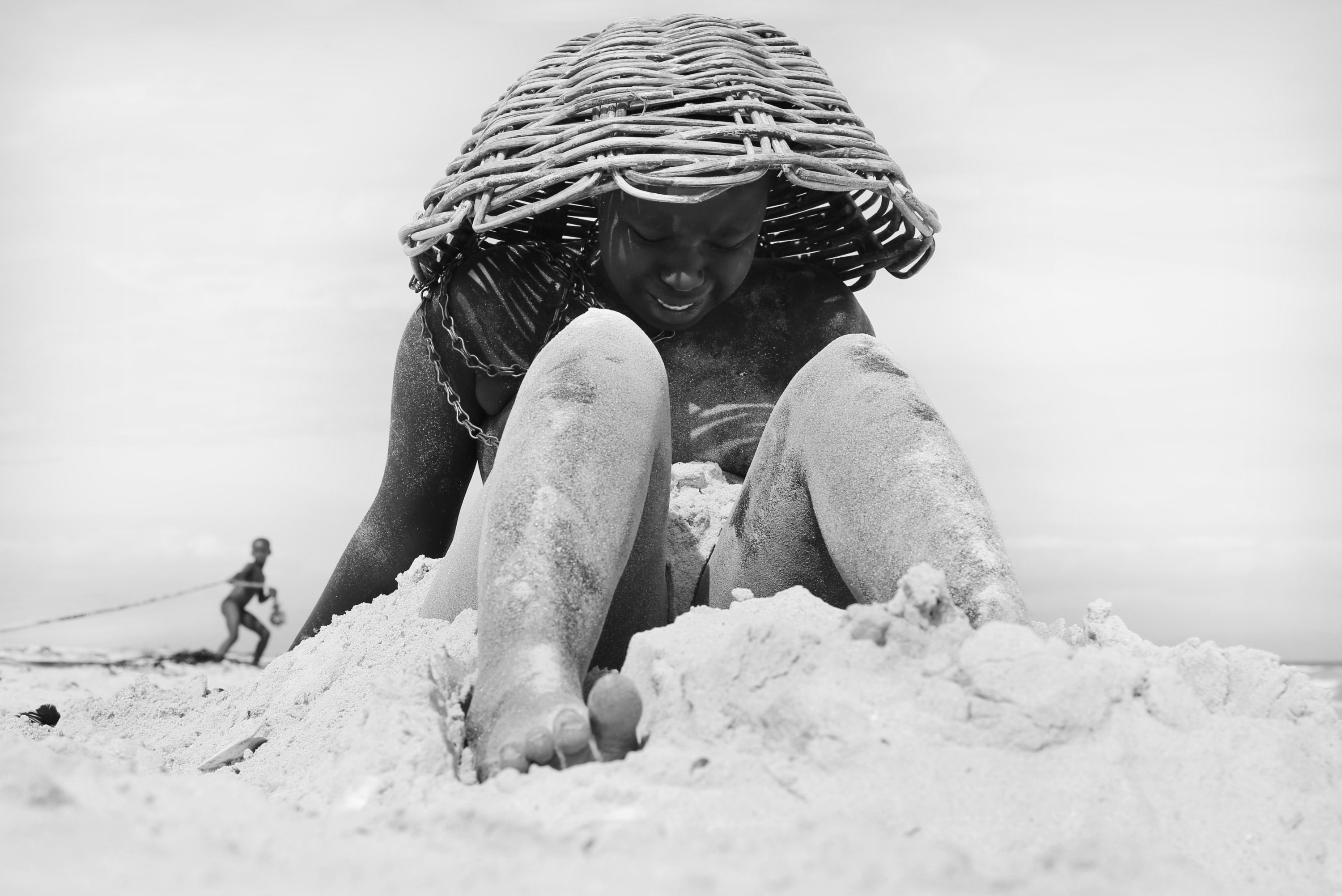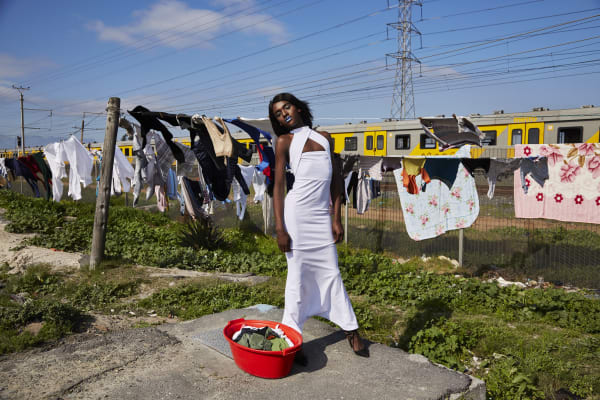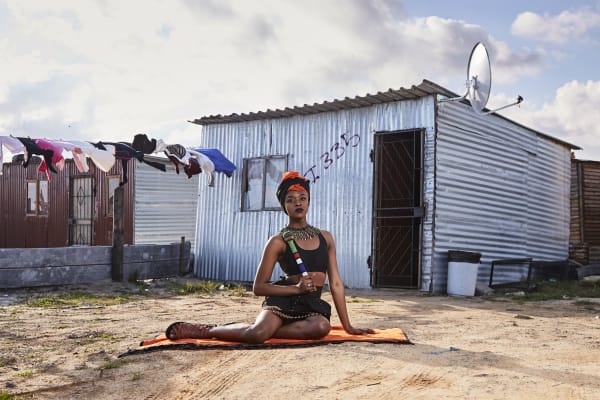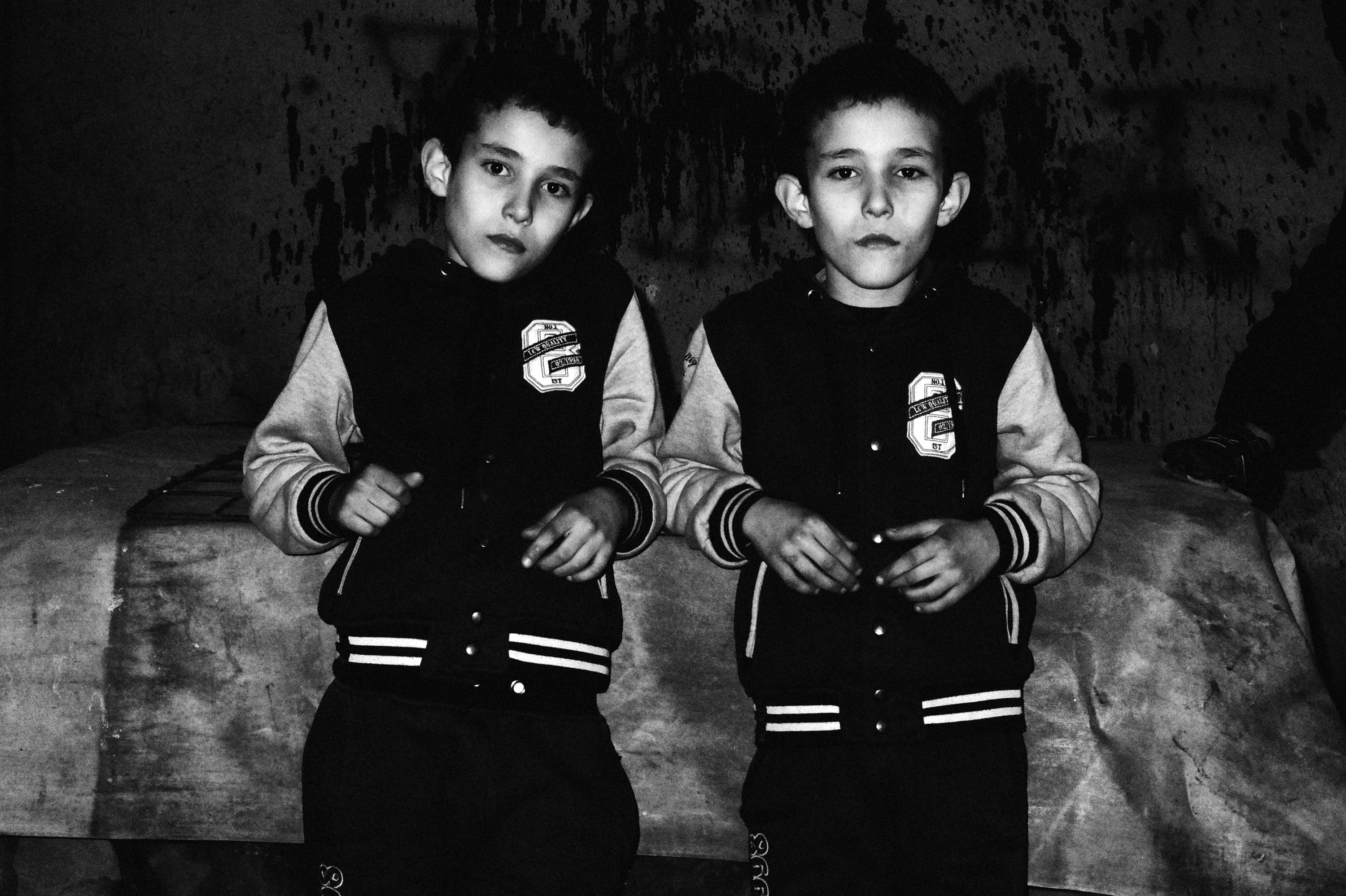The Photography Legacy Project and The Melrose Gallery present ‘Shifting Narratives’, an exciting group exhibition of photographic works created by more than 40 photographers from across the African continent.
Presented online on this viewing room, ‘Shifting Narratives’, will run from 1 March to 3 April and will follow on from the well-received inaugural PLP auction last year which generated substantial funding to support their efforts to archive important photographic works from the Continent of Africa.
The exhibition brings together an exciting diversity of subject matter ranging from social and physical landscapes to private interiors to gender-based issues and surfing culture. This body of photographs reflects the ingenuity and commitment of African photographers who continue to practice their craft despite extreme challenges.
-
List of Participating Artists
Abdo Shanan (Algeria 1982-)
Alan Van Gysen (South Africa 1982-)
Alf Kumalo (South Africa 1930-2012)
Chris Dennis Rosenberg (Uganda 1997-)
Clint Strydom (South Africa 1973-)
David Lurie (South Africa 1951-)
Daylin Paul (South Africa 1985-)
Ernest Cole (South Africa 1940-1990)
Etinosa Yvonne (Nigeria 1989-)
Eyoeal Kefyalew (Ethiopia 1994-)
Fatoumata Diabaté (Mali 1980-)
Fethi Sahraoui (Algeria 1993-)
Gordwin Odhiambo (Kenya 1993-)
Graeme Williams (South Africa 1961-)
Greg Marinovich (South Africa 1962-)
Henion Han (South African 1952 - 2018)
Ilan Godfrey (South Africa 1980-)
Imane Djamil (Morocco 1996-)
Jean Brundrit (South Africa 1966-)
Jillian Edelstein (South Africa 1957-)
Lee-Ann Olwage (South Africa 1986-)
Lindeka Qampi (Botswana 1969-)
Mandisa Buthelezi (South Africa 1991-)
Marc Shoul (South Africa 1975-)
Matthew Kay (South Africa 1985-)
Micha Serraf (Zimbabwe 1994-)
Michael Meyersfeld (South Africa 1940-)
Michelle Loukidis (South Africa 1969-)
Misper Apawu (Ghana 1994-)
Nobukho Nqaba (South Africa 1992-)
Nuits Balnéaires (Côte d'Ivoire 1994-)
Nyancho NwaNri (Nigeria 1988-)
Paul Weinberg (South Africa 1956-)
Pippa Hetherington (South Africa 1971-)
Raïssa Karama Rwizibuka (Democratic Republic of the Congo 1997-)
Ralph Ndawo (South African 1932-1980)
Ronald Ngilima (South African 1914-1960)
Ruth Seopedi Motau (South Africa 1968-)
T. J. Lemon (South Africa 1959-)
Tamary Kudita (Zimbabwe 1994-)
William Matlala (South Africa 1957-)
Lindokuhle Sobekwa (South Africa 1995-)
-
social and physical landscapes
-
A WORLD WITHOUT LIMIT
Brenton MaartThe images ask of us, the viewer, to imagine a world that is beyond the context of hardship, bidding us to extend the potential of the image into our world where, in the words of Azoulay, “photography is an event [that] is never over”, and which “can only be suspended, caught in the anticipation of the next encounter”. And the next encounter could be, if we choose, within the realm of joy and care and love
How satisfying it is – within a contemporary world of disorder, ruination and distress – to be offered a compendium of images by the Photography Legacy Project that surges with positivity. Here is a list of words the artworks prompt: delight, joy and affection; comradeship, friendship and togetherness; pleasure, celebration and play; excitement; exhilaration; thoughtfulness and contemplation; reverence and serenity; beauty and splendour; magic and enchantment; majesty; fantasy, adornment and adoration; performance and pageantry; musical, lyrical, dreamy and poetic; delicate and intimate; hopeful; honour and pride; love.
This collection of works can be described accurately as much by what it shows as by what it chooses not to. A more ‘photographic’ phrase might be that content (the immediately visible and identifiable) is as important as context (that nebulously mysterious ‘present but unseen’), and the world the photographs’ subject lives in, is the world that we, too, inhabit. It is thus doubly delightful that events, isolated within a frame, focus on joys that may, too, exist for us, the viewer, and be shared. It is within the dominion of the repercussive agency of the image – the power to implement a shift – where the joy that emanates from the subjects engages the world of the viewer. At the risk of being melodramatic, this is political agency of love.
In countries in profound socio-cultural and political flux, artists are often advocates. However, these images are themselves activist objects. Via a process of sway from the emotive to the practical, they have the power to alter the environment of the viewer. Not merely a tangible output, the photographs here are as important as their human producers. It would not be a leap of logic, then, to apply the actor network theory to the work these images do in societies of their viewers. The actor network theory asserts that both human and non-human actors are part of the same intellectual framework within the context of technological processes. As such they have equal importance, value, and ability to influence the environment within which they operate. In his 2005 book Resembling the Social, Bruno Latour describes this phenomenon as “objects with agency – things that make something happen”.
Contemporary sociology is a discipline where human actors are assumed to be the primary force of change, but Latour is incredulous that this discipline “remains without object”. A solution to negate this arrogance, he writes, is to ask in reference to an object, “Does it make a difference in the course of some other agent’s action?” By answering, inevitably, “Yes”, it implies that these images of hope and love are not only actors but also, “more precisely, participants in the course of action”. By linking the material and the social, Latour provides an understanding of how “a collective action is possible” by allowing the material objects to do their work. Love is thus political, and these photographs are its champions.
Photography and visual culture theorist Ariella Azoulay, writes in her book, Civil Imagination: A Political Ontology of Photography, about this merger of the aesthetic, the political and the civil. She extends the agency from the artist, via the photograph, to the viewers of photographic images as citizens who are able to “imagine a political state of being that deviates significantly from the prevailing state of affairs”. Thus, in our aspirant decolonial world, these individual images have the capacity to create a collective ecosphere driven by imagination.
Azoulay’s theory stands in stark contrast to the prevailing ontology of photography, and this collection from the Photography Legacy Project upholds her refutations of cultural philosopher Walter Benjamin’s assertion of the separation between the aesthetic and the political, and denounces political theorist Hannah Arendt’s divisions between the public and private worlds. By inference, the subjects in this collection of photographs are presented free of externally imposed status – uplifted beyond political, economic or social strata, transcending class, race and religion, shunning ethnicity and, sometimes, gender. Power relations dissolve; authority and ownership too. The images ask of us, the viewer, to imagine a world that is beyond the context of hardship, bidding us to extend the potential of the image into our world where, in the words of Azoulay, “photography is an event [that] is never over”, and which “can only be suspended, caught in the anticipation of the next encounter”. And the next encounter could be, if we choose, within the realm of joy and care and love.
Brenton Maart
Brenton Maart is an independent artist, writer, designer and curator of contemporary art. His projects include establishing the South African National Art Bank; curating the South African pavilion at the 55th Venice Biennale in 2013; directing the KZNSA Gallery; and curating and designing #i, a project awarded the Contemporary African Photography Award in 2019. He holds an MSc in Biotechnology achieved with distinction from Rhodes University, and an MA in Fine Arts from the University of the Witwatersrand.
-
Ernest Cole
-
 Ernest ColeRevellers at a music festival , circa 1965Silver Gelatin print on fibre-based paper
Ernest ColeRevellers at a music festival , circa 1965Silver Gelatin print on fibre-based paper
Box set of 1251 x 61 cm (unframed)Edition of 12 -
About the artist
Ernest Cole was born in Eersterust, near Pretoria (Tshwane), in 1940 and died in New York in 1990. Cole worked for Drum Magazine, Bantu World and Sunday Times. On his own initiative, he undertook a comprehensive photographic essay in which he chronicled the horrors of apartheid. Out of this emerged the seminal book, The House of Bondage, which was published in New York in 1967.
As Cole wrote in the book, “Three-hundred years of white supremacy in South Africa has placed us in bondage, stripped us of our dignity, robbed us of our selfesteem and surrounded us with hate”. He paid a price for his commitment and documentation – the book was immediately banned and so was he. Cole lived in exile until his death in New York in 1990, a week after Nelson Mandela and others were released from prison.
There has been much speculation about what happened to his negatives and prints. Until relatively recently, it was thought all his negatives and many prints were lost. However, in 2017, 60,000 negatives which had been rediscovered in Stockholm, were handed to the Ernest Cole Family Trust by the Hasselblad Foundation. These include never-before-seen South African work, as well as his documentation on the American South and black life in the USA.
The portfolio offered by the Ernest Cole Family is a part of this ‘lost’ archive and legacy. The PLP is working with the Ernest Cole Family Trust, Magnum Photos and Historical Papers, Wits University, to digitise and make this hidden work accessible for educational and research purposes. This Estate Edition of 20 x 24” silver gelatin prints, feature twelve iconic images from House of Bondage (1967) and Ernest Cole: Photographer (Hasselblad Foundation / Steidl, 2010). They have been printed from the lost negatives of Ernest Cole by Dennis da Silva, South Africa’s premier black and white photography printer, and produced through the Ernest Cole Family Trust in South Africa.
-
-
 Ernest ColeDriving Lesson, circa 1965Silver Gelatin print on fibre-based paper
Ernest ColeDriving Lesson, circa 1965Silver Gelatin print on fibre-based paper
Box set of 1251 x 61 cm (unframed)Edition of 12 -
-
Michael Meyersfeld
-
Context of the artworks
From the series Dark City Dreams
-
Alex Singers
-
Drummer Boy
“Over lunch Poet Laureate Mongane Serote was discussing his childhood in Alex, describing his deprivations and hardships. I asked him whether there wasn’t also a brighter and carefree side to Alex at that time. With his inimitable chuckle he answered, ‘Of course, there is always some lightness even when things seem dark’. I countered, ‘I would like to do an exhibition of today’s Alex showing the celebratory side of this community’.
‘Wonderful,’ he said, ‘and I will write the poems’.
This was the birth of Dark City Dreams, a title given by Mongane to express his childhood experience living in a community without services or electricity. Two years were spent walking the streets of Alexandra township with my friend and assistant, Benson Mokamo.”
Dark City Dreams has been exhibited at the South African Jewish Museum (Cape Town, 2014); Toto Gallery (Johannesburg, 2014); Phutaditjaba Community Centre (Alexandra, Johannesburg, 2014); and the Pretoria Art Museum (2015).
The following are the two poems that accompanied Alex Singers and Drummer Boy.
Alex Singers.
When the children
in their spirit and being
play at the good things of the adults
life must smile and laugh
for
the future is assured
Drummer Boy.
The largest drum drums
to pump the heart
and the little ones know this
and so
they sing
About the artist
Michael Meyersfeld lives and works in Johannesburg. After obtaining a degree in commerce at the University of the Witwatersrand, he entered the family steel merchandising business. During this period, he was an active member of the Camera Club of Johannesburg and contributed to many international photo salons and exhibitions. At the age of forty, he gave up the world of commerce and pursued advertising photography for several decades. His fine art work slowly took over and today remains his sole photographic pursuit.
His work is notable for its stark, sometimes sombre, lonely and edgy imagery that has separateness from reality. He is not comfortable being drawn into giving explanations – his titles are deliberately obtuse, nudging the viewer to uncover what memory or emotion that particular image has stirred in them, moving them to reflect and respond in their own personal world.
Meyersfeld’s photographic activities in the past decade have centred around exhibitions and refining of his approach to fine art photography. He has numerous awards, including a Gold at the London AOP Awards. -
-
ETINOSA YVONNE
-
 Etinosa YvonneLike We Own It, 2019Archival Ink Print on Hahnemuhle Photo Rag 300g30 x 42 cm (unframed)Edition 1 of 4 plus 2 artist's proofsR 17,250.00
Etinosa YvonneLike We Own It, 2019Archival Ink Print on Hahnemuhle Photo Rag 300g30 x 42 cm (unframed)Edition 1 of 4 plus 2 artist's proofsR 17,250.00Context of the artworks
“I began solo traveling in 2015. While I haven’t covered all 36 states in Nigeria, I have been to all the regions in the country. However, I am always in awe whenever I travel to the northern part of Nigeria - while Nigerians are quite colourful, there is an unmatched vibrancy that exists in the north.
In June 2019, while in Zaria for an assignment and subsequently a vacation, I seized the opportunity to capture the beauty, joy and colours that come with the Sallah celebration.”
To celebrate Black History Month, Colours of the North was used as a resource to teach photography to a group of young adults in the UK in 2020. The workshop was organised by Hundred Heroines.About the artist
Etinosa Yvonne is a self-taught documentary photographer and visual artist based in Abuja, Nigeria. The primary focus of her work is on exploring and expressing themes related to the human condition and social injustice. She was one of six photographers selected for the 2020 cycle of the World Press Photo 6*6 Africa talent, and has received grants from Women Photograph, National Geographic in partnership with Lagos Photo and Art X, as well as an award from the Royal Photographic Society for her project, It’s All In My Head. Her works have been shown in selected group exhibitions and featured in several international publications.
-
 Etinosa YvonneThis Bond Between Us, 2019Archival Ink Print on Hahnemuhle Photo Rag 30030 x 42 cm (unframed)Edition 1 of 4 plus 2 artist's proofsR 17,250.00
Etinosa YvonneThis Bond Between Us, 2019Archival Ink Print on Hahnemuhle Photo Rag 30030 x 42 cm (unframed)Edition 1 of 4 plus 2 artist's proofsR 17,250.00 -
Clint Strydom
-
-
Context of the artwork
Battle of Isandlwana is a photograph taken by Clint Strydom of the historic Isandlwana Battle site. During this battle, the British experienced their biggest defeat in their Colonial history when they clashed with the armies of King Cetshwayo.
This battle has become a symbol of Zulu and South African pride and Battalions from the United Kingdom still visit Isandlwana every year for battle re-enactments.
Living in KwaZulu Natal, Clint noticed that most of the monuments at Isandlwana speak from a British perspective. He wanted to create a body of artworks that celebrated the Zulu victory from an African perspective.
He visited the area and after seeking advice from the community, invited a respected member of the community to walk with him to the top of a hill that would provide a bird’s eye view of Isandlwana. The white stones mark the grave sites from the Battle of Isandlwana.
Clint waited for the right moment to take this final shot. On the fourth day, the skies began to ‘show off’ and Clint was able to capture the ‘victorious warrior’ against the backdrop of the rejoicing clouds. The skies that day evoke the warriors state of mind and are symbolic of the mighty power that the Zulu nation exerted over their enemies.
-
Eyoeal Kefyalew
-
 Eyoeal KefyalewKazanchis I , 2018Archival Ink Print on Hahnemuhle Photo Rag 300g32 x 32 cm (unframed)Edition 3 of 20R 11,500.00
Eyoeal KefyalewKazanchis I , 2018Archival Ink Print on Hahnemuhle Photo Rag 300g32 x 32 cm (unframed)Edition 3 of 20R 11,500.00Context of the artworks
The image featured forms part of a body of work that explore the multiple layers found in our surroundings using light as a tool to identify the degree of visibility. The shadows in contrast with saturated images create a flattening in the images that encourages the viewer to consider a confrontation between the comfortable and the familiar with the dark and heavy elements of the environment. The swiftness of street photography allowed me to capture the bodies pronouncing gestures that recall intimacy in the conversations the figures carry with each other.
About the artist
Hailing from Ethiopia’s capital Addis Ababa, Eyoeal is passionate about photography and graphics design. Though he enrolled at Addis Ababa University’s school of Architecture, his true calling was in photography and graphic design and he dropped out of college. From a very young age, Eyoeal has been fascinated with graphics design and his passion for the art form generated a keen interest in photography. His works has been exhibited at Addis Foto Fest 2018, UPPA: East African Photography Award 2019 and has been published on Out of the Phone: Mobile street Photography book.
-
 Eyoeal KefyalewPiassa II, 2018Archival Ink Print on Hahnemuhle Photo Rag 30032 x 32 cm (unframed)Edition 5 of 20R 11,500.00
Eyoeal KefyalewPiassa II, 2018Archival Ink Print on Hahnemuhle Photo Rag 30032 x 32 cm (unframed)Edition 5 of 20R 11,500.00 -
Nobukho Nqaba
-
 Nobukho NqabaNdinikezele , 2016Archival Ink Print on Hahnemuhle Photo Rag 300g60 x 42 cm (unframed)Edition 3 of 8R 23,000.00
Nobukho NqabaNdinikezele , 2016Archival Ink Print on Hahnemuhle Photo Rag 300g60 x 42 cm (unframed)Edition 3 of 8R 23,000.00 -
ILAN GODFREY
-
 Ilan GodfreyRitual offering, Vaal River, Maccauvlei area, Free State, 2011Archival Ink Print on Hahnemuhle Photo Rag 300g71 x 89 cm (framed)
Ilan GodfreyRitual offering, Vaal River, Maccauvlei area, Free State, 2011Archival Ink Print on Hahnemuhle Photo Rag 300g71 x 89 cm (framed)
Edition 1 of 10 plus 2 artist's proofsR 18,400.00Context of the artwork
Ritual offering, Vaal River, Maccauvlei area, Free State, 2011; from the series Legacy of the Mine “Jeremiah Stoaba and his wife Maria from the Apostolic Church of Zion perform an animal sacrifice on the banks of the Vaal River in the Maccauvlei area, on the periphery of the New Vaal Colliery. Two to three times a year they speak to the ancestral ‘river gods’ here. The banks of the Vaal River are rich in minerals, including coal, copper, gold, uranium and other associated minerals, yet is relatively unscarred by mining. There has been a lot of controversy around the award by the Department of Mineral Resources of prospecting rights to mining companies along the Vaal River. If the development of mining continues, it would have a major impact on the ecology of South Africa’s most important river.”
This work is part of a larger project and book which evolved over two and a half years into the Legacy of the Mine – an unflinching series that set out to expose the unwanted and perhaps under-explored legacy confronting South Africa’s land and people by giving agency to those whose lives and livelihoods have been destroyed by mining processes and the long-term environmental ramifications.
Godfrey received the prestigious Ernest Cole Award in 2012 to complete this project. Legacy of the Mine was published by Jacana(2013) and launched in conjunction with solo exhibitions across South Africa. Since then, the project has received multiple international awards and accolades including the CAP (Contemporary African Photography) Prize, Leica Oskar Barnack Award, and the OPENPhoto Award.
Various works from the project have been exhibited at leading photography festivals, galleries and
museums including the Völklinger Hütte World Heritage Site, Germany; Lagos Photo Festival, Nigeria; Image Afrique, Switzerland; and the South African Jewish Museum.
About the artist
Ilan Godfrey's work explores the diverse social, political, economic and environmental currents that shape contemporary South Africa – giving viewers a broader, and at the same time more deeply personal, understanding of the country they live in. His photographic practice includes extensive research. Through a process of investigative narration and long-term, multi-layered projects, Godfrey focuses on the constantly shifting landscape and reveals varied aspects of societal change across the country, documenting the country with an in-depth and intimate conscience.
His work has been recognised by various international photography awards and grants, and exhibited in galleries and museums worldwide, including the National Portrait Gallery (London), Iziko South African National Gallery (Cape Town), Wits Art Museum (Johannesburg), and Musée du quai Branly (Paris); Godfrey’s photographs have been featured in leading international publications such as The New Yorker, Le Monde Magazine, ZEIT Magazine, The Sunday Times Magazine, Guardian Weekend Magazine and the Financial Times Magazine. Aside from his editorial work, he collaborates with institutions and organisations worldwide, regularly working on commissions for global brands, including the Open Society Foundation, Bill and Melinda Gates Foundation, MasterCard Foundation, Barclays Bank, VISA Card, Toyota Mobility Foundation and GlaxoSmithKline.
He holds a BA (Hons) degree in Photography from the University of Westminster (London) and was awarded the David Faddy Scholarship to continue his studies, receiving an MA degree in Photojournalism from the same institution. Godfrey was awarded the Ernest Cole Award in 2012.
-
Paul Weinberg
-
 Paul WeinbergEarthsongs, 2019 - 2021Digital Archival print on Hahnemuhle Photo Rag88 x 63 cm
Paul WeinbergEarthsongs, 2019 - 2021Digital Archival print on Hahnemuhle Photo Rag88 x 63 cm
84 x 60 cm (unframed)Edition of 10 plus 2 artist's proofsR 36,345.00 R 35,000.00 (unframed)Context of the artwork
EarthSongs
Mik, cave church on the Orange River, that has been used by nomadic Nama communities as a place of worship for centuries, Pella, Northern Cape, 2021.
“EarthSongs is a project that explores and celebrates spiritual connections to the land in South Africa. While ‘land’ is a very contested issue, the way people have marked, and celebrated the land remains a critically important, often muted engagement, signifying re-imagining of the land and what the land can mean for a variety of its inhabitants.
In quiet ways beyond the news and headlines, people of all persuasions, faiths and spiritual engagements partake in rituals, formal and informal that mark the land in ways that align with their belief systems. Examples of this are spiritual sites of faith – pilgrimages, archaeological sites, natural wonders, and events where informally spiritual practice take place in the broadest way possible.
This project also explores lesser-known, off the beaten track or unrecognised, unusual sites of spiritual practice and ritual. My project is to look at the landscape and its transformation with regard spirituality. This is an amalgam of different and diverse connections, signifying spiritual connections to land in South Africa.”
This project is a continuation of Weinberg’s work in Moving Spirit, which explored spiritual practicesf a variety in southern Africa.
About the artist
Paul Weinberg is a photographer, curator, filmmaker, writer, educationist, and archivist. He began his career in the early 1980s by working for South African NGOs and photographing current events for news agencies and foreign newspapers. He was a founder member of Afrapix and South, the collective photo agencies that gained local and international recognition for their uncompromising role in documenting apartheid and popular resistance to it. From 1990 onwards, he increasingly concentrated on feature and in-depth projects. He has been published and exhibited widely over a period of 40 years.
In his career he has produced 18 books as a photographer and author, and has been published in many other anthologies and group projects. He taught photography at the Centre of Documentary Studies at Duke University (Durham, USA) and holds a master’s degree from the same university. Weinberg lectured in Documentary Arts and Visual Anthropology at the University of Cape Town and is currently a research associate at the Centre for South African Art and Visual Culture, University of Johannesburg.
Together with David Goldblatt, he founded the Ernest Cole Award for creative photography in southern Africa. He currently works as a curator, archivist, and photographer.
-
Mandisa Buthelezi
-
 Mandisa ButheleziUbhuku LukaMenzi 17 , 2019Archival Ink Print on Hahnemuhle Photo Rag 300g42 x 60 cm (unframed)Edition 2 of 25R 17,250.00
Mandisa ButheleziUbhuku LukaMenzi 17 , 2019Archival Ink Print on Hahnemuhle Photo Rag 300g42 x 60 cm (unframed)Edition 2 of 25R 17,250.00 -
Fethi Sahraoui
-
Context of the artwork
From the series Stadiumphilia
-
Members of the Ultras Verdé Corazon performing one of their chants, 2017
“Stadiumphilia is about what the stadium contains in terms of affective and visceral levels of male experience. Football is wildly popular in Algerian culture. Since the Black Decade, the infrastructure for public mass entertainment has largely disappeared outside the major cities, with the exception of football stadiums, which have become one of the only places apart from religious services where large crowds are permitted to congregate for hours in public. Sahraoui is especially interested in unaccompanied minors, who are usually barred from entering the stadium but who come anyway, cheering from beyond its walls if they fail to find a way past the guards.
Sahraoui sees the football supporters’ enthusiasm and fierce desire to participate as spectators as an allegory for social conditions in Algeria, rather than simply as an allegiance to the game itself. He also understands the public protests that took place in Algeria in the lead-up to the presidential elections as having been rehearsed in the stadium, born of the solidarity learned as fans.”
-
From Waiting for Omar Gatlato: Contemporary Art from Algeria and its Diaspora, catalogue text by Natasha Marie Llorens
Images from Stadiumphilia have been exhibited at the Museum of Modern Art of Algiers (2017);Cité Internationale des Arts (Paris, 2017);L’uzine (Casablanca, 2018); Addis Foto Fest (Addis Ababa, 2018);Galerie de Thorigny (Paris, 2019); Völklinger Hütte World Heritage Site (Völklingen, 2020) and Photoforum PasquArt (Biel/Bienne, 2020).From the series Escaping the Heatwave
-
Ismael and his friends inside a water Tower, Mascara, Algeria, 2016
“Escaping the Heatwave documents the same demographic [as Stadiumphilia] in search of relief from the heat of the summer. Algeria has roughly 1000 miles of coastline, yet for those living even forty miles inland, the sea can feel inaccessible during the height of the season. Without public pools and other such amenities, children find abandoned water towers, irrigation channels, and streams of agricultural runoff to cool themselves in.
If Stadiumphilia revolves around a collective experience that bears political fruit, Escaping the Heatwave traces the same generation’s ingenuity and willingness to invent solutions to systemic problems on a more quotidian level. This latter series centers on the body’s experience of the extremes of the Algerian landscape, and the inexorable range of responses of which this generation is capable.”
-
From Waiting for Omar Gatlato: Contemporary Art from Algeria and its Diaspora, catalogue text by Natasha Marie Llorens
Images from Escaping the Heatwave have been exhibited at Contemporary African Photography (Basel, 2017); Sciences Po (Aix, 2018); Photoville (New York City, 2018); and the Tropenmuseum (Amsterdam, 2021).
The Cult of Souls
A man who fainted after entering in a trance dance under the gasba music rhythms, Mascara, Algeria, 2017.
The Cult of Souls has been exhibited at Photo Doc (Paris, 2019) and Photoville (New York City, 2019).
About the artist
Algerian photographer Fethi Sahraoui was born in the Southern town of Hassi R'Mel. He became a fulltime photographer after studying foreign languages at the University of Mascara, graduating in 2018. Sahraoui’s work has been exhibited at institutions like the Arab World Institute (Paris), Tropenmusuem (Amsterdam), and Museum of Modern Art of Algiers, and featured in publications such as the The New York Times. He is a member of the Everyday Projects and the Algerian photographers’ collective, Collective220, a Magnum Foundation fellow, and was selected for the last edition of the World Press Photo Foundation’s Joop Swart Masterclass.
-
-
Imane Djamil
-
 Imane DjamilTarfaya Buried Open Door (From the '80 Miles to Atlantis' Project), 2020Archival Ink on Print Hahnemuhle Photo Rag 300g50x 75 cm cm (unframed)Edition of 5R 28,750.00
Imane DjamilTarfaya Buried Open Door (From the '80 Miles to Atlantis' Project), 2020Archival Ink on Print Hahnemuhle Photo Rag 300g50x 75 cm cm (unframed)Edition of 5R 28,750.00Context of the artwork
From the series 80 Miles to Atlantis
-
By the yard III
-
Tarfaya buried open door I
“In 80 Miles to Atlantis, the second part of her work around the city of Tarfaya, Imane Djamil works closely with a group of friends born amongst the ruins, in search of a long-lost time they haven’t known, fantasised from a nostalgia point of view. Together, they reinvest in desolation as a playground and the ruin as an element to reclaim in this collaboration. The series interrogates the multiple layers of symbolism in the built and natural landscape, colonial architecture’s redefinition over time, and the blurring of lines between reality and myth. The themes her work explores are of poignant relevance to today’s world – the quest for a symbiosis between urban development and the natural environment, the state’s failure to uplift communities at the margins, and negotiating relationships between the colonial past and a post-colonial present and future.
Through her practice, Djamil never ceases to confront the complexity of people vis-à-vis their physical environment. The title of the series refers to Tarfaya not by its name, but rather its close proximity to Spain’s Canary Islands, the approximate location of where the mythical Atlantis is rumoured to be. The title also likens Tarfaya to the fictional island nation – a fitting relation given that, like Atlantis, it is shrouded in mystery and often described as ‘apocalyptic’ or ‘the abandoned world.’ Working in an environment where interest in street photography and its candid, unmediated images of Moroccan daily life have exploded in the past decade, Imane Djamil stands out from her peers for her use of ‘docu-fiction’ to capture reality while simultaneously introducing fictional scenarios to strengthen its representation through a form of artistic expression.”
From 80 Miles to Atlantis catalogue text by Tina Barouti
About the artist
Imane Djamil is a Casablanca-based artist whose practice spans photography, storytelling, and creative writing. Her work, located at the crossroads of fine art and documentary photography, straddles a fine line between reality and the sublime in what she calls ‘mental geographies' and explores places in post-traumatic transition, where history engenders a metaphorical dialogue with personal anecdotes.
Djamil has participated in several residencies including Escales liées at the French Pavilion of the Venice Architecture Biennale, Italy (2018); Mujeres yel Mediterráaneo at the Casa Mediterraneo in Alicante, Spain (2019); and most recently the Summer’s Lab at le Cube Independent Art Room in Rabat, Morocco (2020). Her work has been exhibited throughout Europe and Morocco, most notably as part of Le Maroc Contemporain at Institut du Monde Arabe in Paris, France (2014) and En un instante: Marruecos at Casa Árabe as part of PHotoESPAÑA’s official selection (2018). In 2021, she was awarded the New Narratives in Environmental Photography prize by Fisheye magazine and La Gacilly Photo Festival for 80 Miles to Atlantis. -
-
 Imane DjamilArmas Essalama , 2020Archival Ink Print on Hahnemuhle Photo Rag 300g42 x 60 cm (unframed)Edition 1 of 2R 28,750.00
Imane DjamilArmas Essalama , 2020Archival Ink Print on Hahnemuhle Photo Rag 300g42 x 60 cm (unframed)Edition 1 of 2R 28,750.00 -
Alf Khumalo
-
 Alf KhumaloDancing Ladies - Dance is music in motion (phata-phata), circa 1960Archival Ink Print on Hahnemuhle Photo Rag 300g60 x 42 cm (unframed)Edition 1 of 10R 57,500.00
Alf KhumaloDancing Ladies - Dance is music in motion (phata-phata), circa 1960Archival Ink Print on Hahnemuhle Photo Rag 300g60 x 42 cm (unframed)Edition 1 of 10R 57,500.00 -
 Alf KhumaloMiriam Makeba Performing in Lesotho , 1981Archival Ink Print on Hahnemuhle Photo Rag 300g60 x 42 cm (unframed)Edition 1 of 10R 69,000.00
Alf KhumaloMiriam Makeba Performing in Lesotho , 1981Archival Ink Print on Hahnemuhle Photo Rag 300g60 x 42 cm (unframed)Edition 1 of 10R 69,000.00Context of the artwork
Miriam Makeba performing in Lesotho
Miriam Makeba sweats with emotion at a stage performance in Lesotho, 1981. Makeba, living in exile at the time, attended the event which Kumalo had organised with businessman Blowie Moloi.
-
David Lurie
-
 David LurieGugulethu, Cape Town (from Images of Table Mountain), 2005Archival Ink Print on Hahnemuhle Photo Rag 30042 x 60 cm (unframed)Edition 4 of 8R 17,250.00
David LurieGugulethu, Cape Town (from Images of Table Mountain), 2005Archival Ink Print on Hahnemuhle Photo Rag 30042 x 60 cm (unframed)Edition 4 of 8R 17,250.00Context of the artworks
From the series Images of Table Mountain
-
District 6, Cape Town
-
Gugulethu, Cape Town
-
Nolungile Station, Khayelitsha, Cape Flats
“This shadow of guilt, of fear and denial – a shadow shadowed in turn by a bounteous and hysterical glee – is revealed in a strategic yet strikingly unmotivated way in David Lurie’s photographs. By unmotivated, I mean that Lurie does not intend to reveal to us the monstrosity of life lived at the foot of a mountain […] It is therefore a photographic project which does not appeal to the viewer’s conscience, but to a certain ethical nerve that is not wholly a matter of mind […] Lurie’s black and white photographs are shadow works, or, works caught in the physical and darkly mythic shadow of Table Mountain.
[…] None of these images are posed or stately. Rather, as if seen through a rear-view mirror, at once backwards and forwards, they quicken a nerve, combust a settlement, allowing the viewer a state of seeing that is neither that of the flaneur or the voyeur, but rather that of Iggy Pop’s passenger: ‘I am a passenger / and I ride and I ride…’
[…] Sometimes the mountain appears as a mere sliver on the distant horizon, sometimes it appears in fragments in the urban thicket. Never is the mountain memorialised. When the mountain dominates the frame it also engulfs it. As a long shot or close up the mountain invariably disturbs the frame. Never is the mountain steadied in a medium shot, and, as a consequence, never is the mountain naturalised or perceived as a normative framing register. This decision is not merely a perverse one. Rather, what this decision suggests is the complexity and the uncertainty of human habitation in relation to the mountain.”
-
From ‘Shadow of the Mountain’ by Ashraf Jamal, Images of Table Mountain (Bell-Roberts, 2006).
Exhibitions of Images of Table Mountain include Bell Roberts Gallery, Cape Town; Standard Bank Gallery, Johannesburg; Hereford Photography Festival, UK; and Bonani Africa, Johannesburg.
About the artist
David Lurie lives and works in Cape Town. He studied economics, politics and philosophy, taught philosophy, did research in international political economy at the London School of Economics, and worked as a consultant economist before turning to photography. Lurie lived for many years in London, where he began doing documentary projects part-time in 1990 and full-time from 1995, following the publication of his first book, Life in the Liberated Zone. He moved back to Cape Town permanently in 2011.
His work has been widely published and exhibited in the United Kingdom, Europe, the United States, Australia, South Africa, and the Middle East. He is the recipient of several awards including Pictures of the Year International, the World Understanding Award for Cape Town Fringe: Manenberg Avenue is where it’s Happening; Nikon (UK); Ilford Pro Photo (SA); and Arts Council of Great Britain Grant Awards.
His monographs are Karoo – Land of Thirst (Hatje Cantz Verlag, 2019); Daylight Ghosts (Hatje Cantz Verlag, 2018); Undercity – the other Cape Town (Hatje Cantz Verlag, 2017); Images of Table Mountain, (Bell-Roberts, 2006); Cape Town Fringe: Manenberg Avenue is where it’s Happening, (Double Storey Books,2004); and Life in the Liberated Zone, (Cornerhouse, 1995). Dreaming the Street will be published by Skira in 2022.
-
-
Jean Brundrit
-
 Jean BrundritValued Families , 1995Glossy Ilford multigrade fibre paper40 x 30 cm (unframed)Edition 14 of 20R 17,250.00
Jean BrundritValued Families , 1995Glossy Ilford multigrade fibre paper40 x 30 cm (unframed)Edition 14 of 20R 17,250.00Context of the artwork
Valued Families
“Valued Families comprises of two images overlaid. Beneath is a pinhole photograph of two women’s bodies close together; laid over this is a diagram of a ‘family’ tree of connecting names. The artwork speaks to how we construct our non-biological families and support networks. It inverts the phrase ‘a return to family values’, which is often cited as the answer to all ‘deviation’ and problems in the world by the popular press and conservative leaders.”
Valued Families has been included in numerous exhibitions, including Gay Rights Rites Re-writes, curated by Joan Bellis and Wessel van Huyssteen (Martin Melkhuis, Cape Town; Oliewenhuis Art Museum, Bloemfontein; Gertruse Posel Gallery, Johannesburg; University of Witwatersrand, 1995-1996); Lifetimes: an exhibition of Southern African art, curated by Ruth Sack and Nina Jacobson, as part of the Out of Africa Cultural Festival (Art Bureau, Munich, 1997); Holdings: refiguring the archive, curated by Jane Taylor (University of the Witwatersrand, Johannesburg, 1998); Regards Croises, as part of the 9th Aubenades de la Photographie (Le Château d’Aubenas, Aubenas, 2001); Ten years of Pinhole Photography, a solo exhibition invited by the association La salle d'attente (Saint-Exupery Cultural Centre, Reims, 2002); 40 years: artists and designers from the University of Stellenbosch, curated by Victor Honey (Sasol Art Museum, University of Stellenbosch, 2004); and Out of Site, a solo exhibition (Association for Visual Arts, Cape Town, 2013).
About the artist
Jean Brundrit teaches photography in the Michaelis School of Fine Art, University of Cape Town, and is a National Research Foundation rated researcher. Her research interests are primarily concerned with exploring the environment and identity – her work pertaining to identity is concerned with exploring lesbian identity and strategies of representation within a South African context. As a visual artist, she has exhibited extensively in South Africa and contributed to a number of international exhibitions.
-
MARC SHOUL
-
 Marc ShoulYoung lady rolling her eyes as she gets teased by a patrolling officer during lockdown level 5, 2020Archival Ink Print on Hahnemuhle Photo Rag 300g42 x 60 cm (unframed)Edition 1 of 5R 17,250.00
Marc ShoulYoung lady rolling her eyes as she gets teased by a patrolling officer during lockdown level 5, 2020Archival Ink Print on Hahnemuhle Photo Rag 300g42 x 60 cm (unframed)Edition 1 of 5R 17,250.00Context of the artwork
A young lady rolls her eyes as she gets teased by a patrolling army officer. Lock down level 5, Alexandra, Johannesburg, South Africa, 2020
“Anxiety and fear increased as a national state of disaster was announced in March 2020. Pressed into a morbid game of hide and seek we isolate. Soon after President Cyril Ramaphosa announced the procedures for a 21-day lockdown, the South African National Defence Force were deployed to enforce the new reality and rules. Socially distanced shopping queues snake out into mall parking lots. Trollies overflow with supplies. The banning of liquor and cigarettes sales opened up a massive black market to fill the demand. We stood masked, sanitised, confused and silent. Our hospital systems sat uneasily knowing that it was just a matter of time before the tsunami would hit. South Africa, already in a recession and freshly demoted to ‘junk status’ when the virus arrived, was told to stay home. For many this meant no income, no future.
[…] For many, the walls started closing in and hunger overcame Covid as the most pressing concern. In-between family duties I would traverse the city, I have found, and share, many stories of heartbreak and many visions of a nation at war, not only with a pandemic but also with itself. I needed to shoot life in this time of change. I looked at the dramas and the dramas spoke to me through the images they offered up. Does that mean that all the images are pictures of despair? Indeed, there is plenty of that. But the South African street remains a place of resilience and survival. It has always been that way, and I hope to show that ordinary life goes on, and will flourish, despite this global setback.”
Time Between was selected for the Corona Call group exhibition, in association with Sana Sanaa, Fahrbereitschaft Haubrok, Berlin, 2020
About the artist
Marc Shoul lives and works in Johannesburg. He works largely in portraiture and documentary photography that observes complex social issues. Shoul graduated from the Nelson Mandela Metropolitan University with a BTech in Photography in 1999.
He has had solo exhibitions at: The South African Jewish Museum, Cape Town (2018); Musée Pierre Noël, Saint-Dié-des-Vosges, France (2017); Blue Sky Gallery, Portland, USA (2015); Extraspaszio Gallery, Rome, Italy (2013); Pretoria Art Museum (2012); Quai 1, Vevey, Switzerland (2010); and Atelier de Visu, Marseille, France (2013), where he also completed an artists’ residency. Shoul’s work has been featured at the screenings of Visa Pour L’Image, Perpignan, France and the Ankor Photographic Festival, Siem Reap, Cambodia. His series Landsman featured at Addis Foto Fest 2018, Addis Ababa, Ethiopia. Shoul won the WinePhoto photographic competition with Brakpan and received an honourable mention for Flatlands in 2011.
His work is included in the collections of the Iziko South African National Gallery, Nelson Mandela Metropolitan Museum, as well as The Memmo Foundation in Rome, Italy. He is represented by Panos Pictures in London, UK.
-
Lindokuhle Sobekwa
-
 Lindokuhle SobekwaBond, 2020Hahnemuhle Photo Rag 300g42 x 60 cm (unframed)Edition 1 of 7R 40,250.00
Lindokuhle SobekwaBond, 2020Hahnemuhle Photo Rag 300g42 x 60 cm (unframed)Edition 1 of 7R 40,250.00About the artist
Lindokuhle Sobekwa is a South African photographer born in Katlehong, Johannesburg. He was introduced to photography in 2012 through his participation in the Of Soul and Joy Project – a photography project in Thokoza, a township in the southeast of Johannesburg. During this time, he studied with photographers Bieke Depoorter, Cyprien Clément-Delmas, Thabiso Sekgala, Tjorven Bruyneel and Kutlwano Moagi.
Sobekwa began exhibiting his work in 2013 as part of a group show in Thokoza, organised by the Rubis Mécénat foundation. His photo essay, Nyaope, was published in the Mail & Guardian (South Africa) in 2014. Nyaope was also published in Vice magazine’s annual Photo Issue and the De Standaard (Belgium) in the same year and exhibited at the Turbine Art Fair as part of their new artist feature exhibition. In 2015, Sobekwa was awarded a scholarship to study at the Market Photo Workshop where he completed his Foundation Course. Nyaope was exhibited in the ensuing group show, Free from My Happiness, organised by Rubis Mécénat for the International Photo Festival of Ghent (Belgium); the exhibition toured to additional sites in Belgium and South Africa. A publication, edited by Tjorven Bruyneel, included a selection of the works.
In 2017 Sobekwa was selected by the Magnum Foundation for Photography and Social Justice, New York, to develop the project I carry Her photo of Me. He received the Magnum Foundation Fund to continue with his long-term project, Nyaope, in 2018. Sobekwa’s work has been exhibited in South Africa, Iran, Norway and the USA, and was presented by several galleries at the 2019 edition of Paris Photo. His hand-made photobook, I carry Her photo with Me was included in African Cosmologies at the FotoFest Biennial Houston, curated by Mark Sealy. He joined Magnum Photos in 2018 and became an associate member in 2020.
-
Gordwin Odhiambo
-
 Gordwin OdhiamboKibera - A Changing Community, 2021Archival Ink Print on Hahnemuhle Photo Rag 30042 x 60 cmEdition 1 of 9R 9,200.00
Gordwin OdhiamboKibera - A Changing Community, 2021Archival Ink Print on Hahnemuhle Photo Rag 30042 x 60 cmEdition 1 of 9R 9,200.00 -
GREG MARINOVICH
-
 Greg MarinovichFrisbee, 1995Archival Ink Print on Hahnemuhle Photo Rag 300g42 x 60 cm (unframed)Edition 1 of 10R 17,250.00
Greg MarinovichFrisbee, 1995Archival Ink Print on Hahnemuhle Photo Rag 300g42 x 60 cm (unframed)Edition 1 of 10R 17,250.00About the artist
Greg Marinovich is a highly regarded photojournalist, filmmaker and author who distinguished himself photographing the fatal conflicts that preceded the first democratic elections in South Africa in 1994. He was awarded the Pulitzer Prize for Spot News Photography in 1991 for a series of photographs of African National Congress supporters murdering a man they suspected of being an Inkatha Freedom Party spy.
Marinovich co-authored a non-fiction book The Bang-Bang Club: Snapshots from a Hidden War (Basic Books, 2000) with João Silva that took readers beyond the photographs, giving context to that tumultuous time as well as many personal stories of those involved. He won the Sunday Times Alan Paton Award in 2017 for Murder at Small Koppie: The real story of the Marikana Massacre, an investigative account of the events leading up to the killing of 34 striking miners in South Africa on 16 August 2012. His book Shots from the Edge: A Journalist's Encounters with Conflict and Resilience, in which he documents his experiences covering war and conflict throughout Africa and the world, was published in 2019 (Penguin Randomhouse).
In 2009, Marinovich was the recipient of the Nat Nakasa award for courageous journalism; and from 2013-14 was a Nieman Fellow at Harvard University.
FRISBEE: An African National Congress aligned Self Defence Unit member plays frisbee next to blankets on a line and a severely cut tree at a braai at a safehouse in Thokoza township, South Africa, 1995.
“This Self Defence Unit was under the command of Bonga Nkosi and had some of the youngest child soldiers among their fighters in the most contested section of the so called 'Dead Zone' between the Inkatha Freedom Party controlled migrant workers hostels and some surrounding houses and the ANC aligned residential suburbs.”
This is the first public showing of this image, shot as part of Marinovich’s work on the child soldiers at the front lines during the end of apartheid.
-
Ralph Ndawo
-
 Ralph NdawoShembe Church, July festival ceremony, 1977Archival Ink Print on Hahnemuhle Photo Rag 300g42 x 60 cm (unframed)Edition 1 of 10R 17,250.00
Ralph NdawoShembe Church, July festival ceremony, 1977Archival Ink Print on Hahnemuhle Photo Rag 300g42 x 60 cm (unframed)Edition 1 of 10R 17,250.00 -
 Ralph NdawoSteve Biko funeral, King William's Town, Eastern Cape. South Africa 1977, 1977Archival Ink Print on Hahnemuhle Photo Rag 300g52 x 60 cm (unframed)Edition 1 of 10R 23,000.00
Ralph NdawoSteve Biko funeral, King William's Town, Eastern Cape. South Africa 1977, 1977Archival Ink Print on Hahnemuhle Photo Rag 300g52 x 60 cm (unframed)Edition 1 of 10R 23,000.00 -
T.J Lemon
-
 T.J LemonamaNtombazane, from the series Homecoming celebrations (uKhismus). esiPongweni, 1992Ink on Ilford Gold Fibre Gloss cotton paper30 x 40 cm (unframed)Edition 1 of 10R 23,000.00
T.J LemonamaNtombazane, from the series Homecoming celebrations (uKhismus). esiPongweni, 1992Ink on Ilford Gold Fibre Gloss cotton paper30 x 40 cm (unframed)Edition 1 of 10R 23,000.00Context of the artworks
amaNtombazane, esiPongweni
amaNtombazane prepare for the celebrations of a coming-of-age ritual (umemulo); esiPongweni, Keates Drift, KwaZulu-Natal.
Siqhandolo Mzila, esiPongweni
amaNtombazane prepare for the celebrations of a coming-of-age ritual (umemulo); esiPongweni, Keates Drift, KwaZulu-Natal.
Sunlight, Keates Drift
Married women outside the trading store on the main road; Keates Drift, Kwazulu-Natal.
“I collaborated with Louise Meintjes on a dance project that resulted in the book, Dust of the Zulu: Ngoma Aesthetics after Apartheid (Duke University Press, 2017), which received two awards. In March 2018, the university sponsored an exhibition of my photographs at the Rubenstein Art Centre, Durham. While the book is published in black and white, the exhibition included large colour prints. Another public exhibition was held for the community in the esiPongweni Community Centre.”
About the artist
TJ Lemon began his career in photography in the 1980s as a student covering events at the small university town of Makhanda (then Grahamstown) in the Eastern Cape, South Africa. Lemon was a lecturer in Photojournalism at Rhodes University from 1988–1989. He had three exhibitions in Makhanda before moving to Johannesburg in 1990, where he was appointed as director and trainer at the newly formed Market Photo Workshop. Lemon was also a contributor to the photographers’ collective Afrapix.
After the 1994 elections, he took a staffer position at Independent Newspapers and became chief photographer of The Sunday Independent. He pursued news and feature work as required, but enjoyed the versatility a weekly publication offered. Lemon began writing for his picture features and went on to win a World Press Photo award (2001) for his photo-essay, Oswenka, the Jeppe Hostel Swankers.
In 2010, he left Independent Newspapers to pursue freelance work and long-term photographic projects. Lemon taught in the Journalism department, Wits University, from 2013–2015. He collaborated with Louise Meintjes from Duke University on the book, Dust of the Zulu: Ngoma Aesthetics after Apartheid (2017), and an exhibition in Durham (2018). His exhibition, Comrades, Warriors and Volkstaat Kommandos, was shown at the National Arts Festival in Makhanda (2019).
-
Graeme Williams
-
Context of the artworks
From the series The Edge of Town
-
Intabazwe township, Harrismith, 2007
-
Thabong township, Welkom, 2005
“This work is from the series The Edge of Town. My initial motivation for the project was to capture a segment of South African life as the country’s struggled to find a new post-apartheid identity. My own reactions to the changes happening around me were mixed and often jarring.
Instead of trying to construct a narrative about life in the country as a whole, I concentrated on fragments of life at the literal and figurative edges of town. It is a stream of consciousness that attempts to draw in the elements of both change and lack of change within this paradoxical country. This essay, like a mosaic, is made up of fragments that I have collected as I moved within the spaces occupied by South Africa’s marginalised communities. These fragments build a picture of the challenges, changes, frustrations and joys experienced by people who are attempting to move from the shadows into the centre stage of South African life.
I wanted to avoid the conventional photographic documentary approach[…] This meant deconstructing my habitual position of observing and photographing a subject from a strongly objective standpoint. The way I went about this was to make use of layers of visual information, and also to photograph from a position that would give a sense of my involvement, thereby communicating something more intimate. […] I constantly had to find a balance between achieving that sense of intimacy and objectivity.”
The Edge of Town was published by Once-Off Publications, 2007.
About the artist
For thirty years Graeme Williams has worked on highly personal photographic essays, reflecting his response to South Africa’s complex evolution. Photographic assignments have taken him to fifty countries and his photographs have been featured in major publications, including National Geographic Magazine, TIME, Newsweek, and The New York Times Magazine. His work is housed in the permanent collections of, amongst others, the Smithsonian (USA), Duke University (USA), North Carolina Museum of Art (USA), Rotterdam Museum of Ethnology (Netherlands), University of South Africa, Iziko South African National Gallery, Apartheid Museum in Johannesburg, and the University of Cape Town.
Williams’ work has been shown in solo exhibitions in New York, Paris London, Cape Town and Johannesburg, and he has participated in many international group exhibitions, including the 2011 Figures and Fictions exhibition at the Victoria and Albert Museum, London. In 2013, he was awarded the CAP (Contemporary African Photography) Prize as well as the Ernest Cole Award for the series, A City Refracted. His work was included in a major exhibition showcasing South African photography at Huis Marseille Museum for Photography in Amsterdam, and in the Aperture Summer Open exhibition in New York in 2014. Images from his series, As the Grass Grows, were included in the Louis Vuitton Foundation’s Being There exhibition in 2017.
-
-
MATTHEW KAY
-
 Matthew KayCricket Nets, 2013Archival Ink Print on Hahnemuhle Photo Rag 300 g32 x 32 cm (unframed)Edition 1 of 10R 3,450.00
Matthew KayCricket Nets, 2013Archival Ink Print on Hahnemuhle Photo Rag 300 g32 x 32 cm (unframed)Edition 1 of 10R 3,450.00About the artist
Matt Kay is a photographer based in Durban, South Africa. Kay studied at the Market Photo Workshop in Johannesburg and is currently completing a fine arts master’s program through the University of the Witwatersrand.
He was the recipient of the Ithuba Arts Trust and the Tierney Fellowship in 2014, during which he was mentored by David Goldblatt. Over the past few years, he has been nominated for several awards, including the Gabriele Basilico Prize in Architecture and Landscape Photography (2015) and PDN global top 30 emerging photographers edition (2016/2017). He was shortlisted for the CAP (Contemporary African Photography) Prize in 2021.
Kay’s solo exhibition, The Front, was shown at the KZNSA Gallery in Durban; his work, Losing Ground, was shown in the Biel/Bienne Festival of Photography in Switzerland (2016). -
Misper Apawu
-
 Misper ApawuThe Jockey and His Horse , 2020Archival Ink Print on Hahnemuhle Photo Rag 300g42 x 60 cm (unframed)Edition 1 of 10R 11,500.00
Misper ApawuThe Jockey and His Horse , 2020Archival Ink Print on Hahnemuhle Photo Rag 300g42 x 60 cm (unframed)Edition 1 of 10R 11,500.00Context of the artwork
The Jockey and his horse
This photograph is part of an ongoing project, The Horse Men, which seeks to look at the bond between horse owners, grooms, jockeys, and their horses.
About the artist
Misper Apawu is a photographer based in Accra, Ghana. Her photographic journey started in 2018 when she attended a mentorship program for six months. In 2019, she made the decision to pursue photography fulltime. She uses the medium to learn about communities, and focus on the social, physical, and emotional aspects of daily life. Apawu wants her photographs to reveal the similarities and differences in everyone's world. She is a member of African Women Photograph and the African Photojournalism Database. She exhibited her work during the Nuku Photo Festival in Ghana, 2018.
-
Ruth Seopedi Motau
-
 Ruth Seopedi MotauGumbot Dancers, Bapedi, Soweto, 1993Archival Ink Print on Hahnemuhle Photo Rag 300g42 x 60 cm (unframed)Edition 1 of 10R 34,500.00
Ruth Seopedi MotauGumbot Dancers, Bapedi, Soweto, 1993Archival Ink Print on Hahnemuhle Photo Rag 300g42 x 60 cm (unframed)Edition 1 of 10R 34,500.00 -
Daylin Paul
-
 Daylin PaulHorse grazing in field near Kriel Power Station - Kriel, Mpumalanga, 2018Archival Ink Print on Hahnemuhle Photo Rag 30053 x 73 cm (framed)Edition 1 of 10R 17,250.00
Daylin PaulHorse grazing in field near Kriel Power Station - Kriel, Mpumalanga, 2018Archival Ink Print on Hahnemuhle Photo Rag 30053 x 73 cm (framed)Edition 1 of 10R 17,250.00Context of the artwork
Horse grazing in field near Kriel Power Station – Kriel, Mpumalanga
This work is from Daylin Paul’s Broken Land, for which he was awarded the prestigious Ernest Cole Award. The series examines the coal-fuelled climate change and human rights crisis in Mpumalanga province, South Africa.
As Paul comments, “These power stations, while providing electricity for an energy desperate South Africa, also have a devastating and lasting impact on the environment and the health of local people. […] Vast tracts of fertile, arable land are being ripped up, the landscape scarred with the black pits of coal mines while coal-burning power stations, are one of the biggest greenhouse gas emitters in the world.”
Paul looks at both the micro and macro issues of coal with a documentarian’s eye: recording evidence and conducting interviews as a journalist would, but also interpreting landscapes and scenes as an artist. The photographs in this series look for traces of the subtle, paradoxical tragedy that haunts the both the land and the people of Mpumalanga: blessed with unfathomable mineral wealth, but cursed by the industries that extract and burn it.
Broken Land was exhibited at KZNSA Gallery, Durban; Wits Art Museum, Johannesburg; and FORMS Gallery, Cape Town. The monograph (Jacana, 2019) was longlisted for the 2021 National Institute for Humanities and Social Sciences awards.
About the artist
Daylin Paul is an independent photographer, writer and educator. He is a graduate from Rhodes University, School of Journalism. After starting his career as press photographer in Cape Town, he decided to work as an independent photographer and travelled to East Asia where he was a stringer for Penta Press photo agency (Seoul, South Korea), and a gallery assistant at Documentary Arts Asia (Chiang Mai, Thailand).
After five years in Asia, Paul returned to South Africa and worked for various leading news organisations, both local and international. His work during the FeesMustFall protests in 2015 and 2016 drew critical acclaim and global recognition, and was published in The New York Times, The Guardian, and Foreign Policy. Subsequently, he was a regional finalist in the Vodacom Journalist of the Year awards (2017).
It was during this time that he began moving away from photojournalism and into documentary photography. Paul was awarded the prestigious Ernest Cole Award in 2017 for his work on coal mining and burning in the Mpumalanga Highveld. This project was published as his debut monograph, Broken Land, and exhibited widely.
He teaches in the Photojournalism and Documentary Photography program at the Market Photo Workshop, and is a writer and contributor to a number of local and international NGO’s and development agencies.
-
Nyancho NwaNri
-
 Nyancho NwaNriFor the Trumpet Shall Sound #EndSARS, 2020Archival Ink Print on Hahnemuhle Photo Rag 300g42 x 60 cm (unframed)Edition 1 of 10R 23,000.00
Nyancho NwaNriFor the Trumpet Shall Sound #EndSARS, 2020Archival Ink Print on Hahnemuhle Photo Rag 300g42 x 60 cm (unframed)Edition 1 of 10R 23,000.00 -
 Nyancho NwaNriHoist the Flag #EndSARS, 2020Archival Ink Print on Hahnemuhle Photo Rag 300g42 x 60 cm (unframed)Edition 1 of 10R 23,000.00
Nyancho NwaNriHoist the Flag #EndSARS, 2020Archival Ink Print on Hahnemuhle Photo Rag 300g42 x 60 cm (unframed)Edition 1 of 10R 23,000.00Hoist the Flag #EndSARS
A protester hoists different flags that read "Reform the Police", "SARS SWAT We Don't Want" and "Buhari #ENDSARS SWAT" at a protest in Alausa, Lagos State Nigeria, during the #End SARS movement. 11 October 2020.
“In this photograph, a protester hoists a flag while standing atop a truck, in an electric moment of national pride and solidarity.” This work was exhibited at Art X Lagos, 2020.
-
contemporary beach culture
-
Nuits Belneaires
-
 Nuits BelneairesApparat, Redemption , 2021Archival Ink Print on Hahnemuhle Photo Rag 300g60 x 82 cm (unframed)Edition 1 of 5R 23,000.00
Nuits BelneairesApparat, Redemption , 2021Archival Ink Print on Hahnemuhle Photo Rag 300g60 x 82 cm (unframed)Edition 1 of 5R 23,000.00Conext of the artwork
Apparat, from the series Rédemption
From the time he moved to Grand-Bassam, Balnéaires took interest in the many environmental challenges that exist there. Discussions on the issue with the inhabitants of the village as well as with specialised NGOs opened his eyes to the complexity and depth of the problem. Between the waste that arrives from the Atlantic Ocean and that dumped by the population for lack of alternatives, the surrounding nature bears the after-effects of an exacerbated human impact. In Rédemption, objects found on beaches are the raw material. Balnéaires collects objects along the coast, sculpts forms and dresses them up, as if to show solidarity with a distressed nature.
About the artist
Nuits Balnéaires is a visual artist based in Grand-Bassam, Côte d’Ivoire. His practice is articulated between photography and film, and he plays a key role in the emerging Ivorian art scene. After completing his studies in Business Management, he decided to devote himself to fashion photography and collaborated with brands such as Lagos Fashion & Design Week and Vlisco & Co.
In 2019, Balnéaires settled in Grand-Bassam to focus on his art. During the same year, his documentation of the floods in Grand-Bassam earned him a one-year visual journalism scholarship with the World Press Photo Foundation. He is the first Ivorian to be selected for this coveted award. In 2020, he was one of the winners of the Cultural and Environmental Responses for Environmental Change initiated by the Prince Claus Fund and the Goethe Institute.
Balnéaires is part of the collection of Foundation Donwahi and his work has been exhibited in Côte d'Ivoire, New York, Toronto, Montreal, Melbourne, and Amsterdam.
-
Micha Serraf
-
About the artist
Micha Serraf is an award-winning commercial and fine art photographer whose work focuses on fashion, social consciousness, and conceptual portraiture. Currently based in South Africa, Serraf was born and raised in Zimbabwe.
Observing foreign nationals in their navigation of post-apartheid South Africa, Serraf notes that they display an acute awareness of the safest shape they need to take to survive in particular contexts. This fluid presentation of self, and the ability to be malleable, are tactics used to access acceptance and camouflage. In this exposure to several ways of existing, Serraf has experienced and observed a variety of gender norms, enactments, and ideologies – seeking to dissect and dismantle the understanding of gender and belonging within this configuration, and demonstrate the evolutionary, fluid, and emotional entanglements related to the purpose, interpretations, and performance of gender, race, and origin.
“Throughout my life, after fleeing Zimbabwe and as an artist, I have been searching for home. Over the last few years, I have decided to embrace being an alien (legal or otherwise). My work is informed by memories I have from when I was a child in Zimbabwe and my endeavour to understand the nostalgia I feel toward the unfamiliar. In an attempt to figure out what I am and where I belong, I will continue to make visual my memories, thoughts and narratives.”
Serraf has participated in several international exhibitions and festivals, and is the recipient of the Ritzau Art Prize with ISCP & 1-54 Art Fair (2021); International Pride Photo Award for Best Single Image (2020); winner of the FastTrack 18 with the British Journal of Photography and 1854 Media (2021); Foam Museum top 20 talents (2020); and Africa Photo Awards Portraiture Finalist (2020).
-
Alan Van Gysen
-
 Alan Van GysenDropping In , 2017Archival Ink Print on Hahnemuhle Photo Rag 300g42 x 60 cm (unframed)Edition 1 of 10R 17,250.00
Alan Van GysenDropping In , 2017Archival Ink Print on Hahnemuhle Photo Rag 300g42 x 60 cm (unframed)Edition 1 of 10R 17,250.00Context of the artwork
Dropping In
Godfather of Nigerian surfing, Godspower Pekipuma, dropping in at Lighthouse Left on Tarkwa Island, Lagos, Nigeria.
About the artist
“Alan van Gysen is one of the world’s most respected surf photographers. With an inextinguishable drive and natural flair, he has spent the past twenty years carving his mark into the international scene. His dedication to his craft has captured the artistry of South Africa’s and the world’s top surfers.” – Brendon Bosworth
As a surf photojournalist, he has travelled the planet to cover stories for major surfing magazines. His lens has also reached beyond the commercial and the well-known surfing personalities and predictable narratives, to tell the story of lesser-known African surf culture. Van Gysen’s work offers surfers from the continent a voice and place in a highly commercialised industry, presenting a counter-vision to how surfing is generally projected.He is also involved in projects like The 9 Miles Project and Waves for Change that have been crucial in supporting at-risk youth to be part of a sport that is often considered exclusionary and elitist. At present he is working with the team from Mami Wata on AfroSurf – the first book of its kind to document African surf culture, which has already received international backing and interest.
-
Jillian Edelstein
-
Context of the artworks
Beach frolic
Personal work created while visiting South Africa after the artist published Truth and Lies: Stories of the Truth and Reconciliation Commission in South Africa in 2003.
St James Beach & Bucket
Personal work created while visiting South Africa after the artist published Truth and Lies: Stories of the Truth and Reconciliation Commission in South Africa in 2003.
About the artist
London-based photographer Jillian Edelstein began her career working as a press photographer in Johannesburg, South Africa. Edelstein’s award-winning portrait and documentary work has appeared in international publications such as The New York Times Magazine, The Sunday Times Magazine, TIME, The New Yorker, and Vanity Fair. She has exhibited internationally at venues including the National Portrait Gallery, The Photographers' Gallery, The Royal Academy, and OXO Gallery in London; Rencontres d’Arles; Espace Muraille, Geneva; Sotheby's Galerie Charpentier, Paris; Dali International Photography Festival, Yunnan Province, China; Bensusan Museum of Photography, Johannesburg; and the Robben Island Museum, Robben Island, Cape Town.
Between 1996 and 2002 Edelstein returned to South Africa frequently to document the work of the Truth and Reconciliation Commission (TRC). Her book, Truth and Lies: Stories of the Truth and Reconciliation Commission in South Africa (Granta / Mail & Guardian, 2003), won several awards including the Visa d’Or at the International Festival of Photojournalism Perpignan in 1997, and the John Kobal Book Award, 2002.
In 2002 Edelstein was awarded a Royal Photographic Society Honorary Fellowship (HonFRPS), and in 2018 she was voted on the ‘Hundred Heroines’ list – an international campaign led by the Royal Photographic Society. She is a Hasselblad Heroine 2020. In the run up to the Olympics 2012 she was commissioned by The National Portrait Gallery to produce a series of portraits of those working to make the Olympic and the Paralympic Games happen. The Road to 2012: Aiming High was opened by the Duchess of Cambridge.
She is currently working on her first feature documentary about the Academy Award nominated screenwriter, Norman Wexler.
-
LINDEKA QAMPI
-
 Lindeka QampiIsana Ilhoye , 2015Archival Ink Print on Hahnemuhle Photo Rag 300g42 x 60 cm (unframed)Edition 1 of 12R 13,800.00
Lindeka QampiIsana Ilhoye , 2015Archival Ink Print on Hahnemuhle Photo Rag 300g42 x 60 cm (unframed)Edition 1 of 12R 13,800.00Context of the artwork
Usana luhoye, from Inside My Heart
In 2015, Lindeka Qampi decided it was time to turn her lens onto herself and her immediate family after she had penned a poem, Inside My Heart, to her late mother: “I have never written a poem before, but I knew I needed to say these words”.
As the series developed through her exploration of self-portraiture, she also investigated other modes of expression. Inside My Heart also includes video work, drawings, and objects made by the artist.
Usana luhoye was included in Qampi’s recent solo exhibition, Ukufa kusembizeni, at the Association for Visual Arts, Cape Town, 2021.
About the artist
Lindeka Qampi is a self-taught South African artist and photographer. She began taking photographs in 2006, when she met members of the Iliso Labantu (the eye of the people), a community-based photo collective. At the start she worked as a street photographer, photographing weddings, events, and portraits. Soon she moved on to exploring her community in different ways, documenting the lives of ordinary people. Her photographs express the poetry and politics of the ‘ordinary act’ and therein the potential of imagining new possibilities for the future. She has participated in numerous group exhibitions in South Africa and abroad.
In 2011, Qampi developed a series of photographs for New York University master’s student, Shady Patterson, which featured township fashions – Clothing and Dress in South African Townships in the Post-ApartheidEra which set out to “explore and interrogate the sartorial landscape of impoverished communities to reveal traditional influences in economically oppressed and media saturated societies”. Qampi went on to produce her own series of photographs, Material Culture, within the trajectory of ‘township fashion’ and ‘street culture’.
Since 2012, and alongside developing her own career as practicing photographer, Qampi has been the project facilitator for Inkanyiso, an activist platform founded by photographer, Zanele Muholi. One of their projects, Empathetic Eyes, led them to Benin where they presented photography workshops which focused on violence against woman. In 2015, they participated in a Visual Activism Cultural Exchange Project. Muholi and Qampi were acknowledged for their outreach work with a Brave Award in 2016.
-
Portraiture
-
PIPPA HEATHERINGTON
-
 Pippa HeatheringtonNomonde Mthandande from the series Cuttings , 1820 - 2020Archival Ink Print on Hahnemuhle Photo Rag 300g60 x 42 cm (unframed)Edition 2 of 20R 13,800.00
Pippa HeatheringtonNomonde Mthandande from the series Cuttings , 1820 - 2020Archival Ink Print on Hahnemuhle Photo Rag 300g60 x 42 cm (unframed)Edition 2 of 20R 13,800.00Context of the artwork
Nomonde Mthandande, from the series Cuttings 1820 – 2020
“Cuttings 1820– 2020 is an enquiry into the difficulty of disentangling our histories through visual storytelling pivoting around the relationship between female descendants of the Eastern Cape Xhosa and the 1820 British Settlers in South Africa. Using clothing and portraiture as a metaphor to symbolise power and identity, this body of work marks 200 years since the 1820 British Settlers landed in South Africa.Two centuries later, female descendants from Xhosa and 1820 Settler families make dresses and sit for portraits, wearing their histories.
The dresses indicate how fabrics represent tangled post-colonial complexities and identity, disrupting the notion that fine art and refined arts and craft were typically associated only with white Europeans. Stylistically informed by carefully composed portraits by Malick Sidibé and Seydou Keita, the work speaks to the democratic camera and the relevance of vernacular photography.
This is a tribute to grief, loss and mourning, woven around family, history, displacement and memory. The thread and fabric connect us to what we have lost, bonding us to the past and the present. We can’t disentangle ourselves from the history of where we come from. Memory is a tapestry of relationships. This work is about heritage, history, kin and remembrance.”
Cuttings 1820 – 2020 was exhibited at the GFI Art Gallery, Gqeberha (former Port Elizabeth) in August 2020.About the artist
Pippa Hetherington is a South African photographer who has been working as an independent photojournalist with a human rights focus. She is co-founder of Behind the Faces – a pan-African women’s storytelling project, launched at Constitution Hill, Johannesburg, in 2013. Her work has been published in international and national publications.
Hetherington’s work has been shown in solo and group exhibitions in Cape Town, Johannesburg, Bloemfontein, Durban, and Gqerbeha (South Africa); London (UK); Dublin (Ireland); and New York City and Washington, DC, (USA). She graduated with an MFA from ICP-Bard, New York, in May 2019.
-
Tamary Kudita
-
 Tamary KuditaGladys, 2021Archival Ink Print on Hahnemuhle Photo Rag 300g84 x 60 cm (unframed)Edition of 20R 46,000.00
Tamary KuditaGladys, 2021Archival Ink Print on Hahnemuhle Photo Rag 300g84 x 60 cm (unframed)Edition of 20R 46,000.00 -
Context of artworks
African Victorian II, 2020
“African Victorian is an environmental portrait captured as a frozen moment from a series of images which explore a broader narrative. The idea behind the photo was to create a visual narrative about an individual and encourage a dialogue of who the individual is, beyond their physical appearance. I wanted to create a short biography by incorporating real African elements used by the individual in everyday life. This vignette was further elaborated by the individual’s attire which is woven seamlessly into the larger context of her identity. I also incorporate a minimalistic scene in the background, which allows the African hut and the individual to become one with the frame. All these distinctive choices were part of the tale that establishes the mood and creates a backdrop for the narrative to begin.
In this photograph, you are looking at a portrait of a nuanced depiction of an African woman. The model is essentially an extension of myself as someone who has a dual heritage. This heritage consists of the Shona culture I was born into and the western culture into which I was assimilated. The African identity is multifaceted and I wanted to bring out her personality by exaggerating her adornments. Through posturing and gesture, I was also able to communicate the strength of her character. Through portraiture, I reimagine the African identity as one which is laced with hybridity and regality.”
About the artist
A product of dual heritage, Tamary Kudita was born in Zimbabwe whilst her ancestry can be traced back to the former Orange Free State. She holds a bachelor’s degree in Fine Arts from the Michaelis School of Fine Art, University of Cape Town, South Africa (2017). Her investigation into the legacy of colonialism on the family structure has resulted in an exploration of post-colonial identity.
Her first solo exhibition (PH Centre, Cape Town) explored notions of race and representation. Previous exhibitions include Maintaining Memories (Michaelis Galleries, Cape Town). Kudita continued her investigation of history with a touring solo exhibition, African Victorian, which was shown at the National Gallery in Harare and the National Gallery of Bulawayo (Zimbabwe). Her most recent work was included in a group exhibition at Ki Smith Gallery, New York City.
She was awarded the Open Photographer of the Year prize at the 2021 Sony World Photography Awards; the VAW Journal most inspiring art piece award (2020); and the Voices of African Women cover book award. Her work has been featured by international media outlets and publications, including CNN International, The Independent, Huffington Post, TSA Contemporary Art Magazine and the British Journal of Photography. -
Lee-Ann Olwage
-
 Lee-Ann OlwageBelinda (from the #BlackDragMagic series), 2019Archival Ink Print on Hahnemuhle Photo Rag 300g42 x 60 cm (unframed)Edition of 10 plus 2 artist's proofsR 34,500.00
Lee-Ann OlwageBelinda (from the #BlackDragMagic series), 2019Archival Ink Print on Hahnemuhle Photo Rag 300g42 x 60 cm (unframed)Edition of 10 plus 2 artist's proofsR 34,500.00Context of the artowrk
Belinda
Belinda Qaqamba Ka-Fassie, a drag artist and activist, poses at a shisanyama – a community space where women cook and sell meat – in Khayelitsha, a township located on the Cape Flats, near Cape Town, South Africa. 4 August 2019.
This image was exhibited in 45 countries as part of the World Press Photo Awards exhibition, 2020, and is currently part of the Pride Photo Award exhibition touring the Netherlands.
About the artist
Lee-Ann Olwage is a visual storyteller from South Africa. She is interested in using the medium of photography as a mode of co-creation and celebration. With her long-term projects, she aims to create a space the where people she collaborates with can play an active part in the creation of images that they feel tells their stories in a way that is affirming and celebratory.
In 2020, she was awarded a World Press Photo Award, Palm Photo Prize shortlist, CAP (Contemporary African Photography) Prize shortlist, Marilyn Stafford Fotoreportage Award shortlist, IPA Honorable Mention, and selected for The New York Times portfolio review. She is a member of Native Agency, Women Photograph and African Women in Photography. -
Context of the artworks
Liyana
Liyana Arianna Madikizela, a young drag artist and activist from Kayamandi, a township outside the university town of Stellenbosch. Madikizela wanted their portrait to challenge traditional gender roles. “I have decided to be myself. I am a gender non-conforming body and I want to be a role model to the future generations of queers to come. I want to become the role model I never saw in the streets of Kayamandi. Living in a township has taught me to be strong and strive. I have dealt with the stigma and hate, and now I am stronger.” 4 August 2019.
Thuli
Mthulic Vee Vuma, a trans woman from Lingelihle township in Malmesbury, is pictured in front of a shack in Khayelitsha dressed in traditional female Xhosa clothing. This is done to challenge binary thinking that strongly differentiates between masculine and feminine traditional clothing. “Here we use our own culture to frame our identity, even though this contests the societal norms and gendered dress codes that are set in our culture. We frame our identity by tying together our stories of subjectivity and culture,” Vuma says. Her family initially struggled to accept her as a trans woman, believing it was a curse, but she says they now give her total support. 4 August 2019.
-
ABDO SHANAN
-
 Abdo ShananUntitled Diary: Exile 2014-2016Hahnemuhle Photo Rag 300g40 x 60 cm (unframed)Open EditionR 11,500.00
Abdo ShananUntitled Diary: Exile 2014-2016Hahnemuhle Photo Rag 300g40 x 60 cm (unframed)Open EditionR 11,500.00About the artist
Abdo Shanan was born in Oran, Algeria. He studied Telecommunications Engineering at the University of Sirte, Libya, until 2006. In 2012, Shanan undertook an internship at Magnum Photos, which gave him the opportunity to reflect on his photographic approach and create his first story for the magazine, Rukh. His photographs have been published by several print and online magazines and newspapers.
In 2015, Shanan received a nomination for the Magnum Foundation Emergency Fund; in the same year he co-founded the Algerian photographers’ collective, Collective220. A year later, his series Diary: Exile was selected for the Addis Foto Fest. He was awarded the 2019 CAP (Contemporary African Photography) Prize for his ongoing project, Dry. In the same year, he was selected for the World Press Photo Foundation’s Joop Swart Masterclass. In 2020, he won the Premi Mediterrani Albert Camus Incipiens award and co-curated Narratives from Algeria, together with Danaé Panchaud, at PasquArt Photoforum in Biel/Bienne, Switzerland.
“Diary: Exile started spontaneously and without direction in 2014. When I started it, I thought I was documenting the life of my grandmother, who suffers from severe memory loss. But many months later, as I looked back at the photographs, I realised that I was creating a diary of myself and for myself. The spontaneous nature of the project kept it instinctive rather than premeditated.
Exile has become a defence from the prefabricated reality, a shield that will protect who I am. Surrounded by solitude, disappointment, fears of the ticking of time, of growing old, of accomplishing nothing. The country has changed. Or perhaps it is just different from the image I created in my head while I was abroad to compensate for my feelings of nostalgia and homesickness while I was growing into a man. Reality hits hard. Accept it and change or refuse it. There may be another way around. A place where you can create your own path away from the expectations and predefined roles and identities.”
-
Chris Dennis Rosenberg
Context of the artworks
This work is part of a long-term project exploring my interactions and relationships with a diverse group of artists encountered on my journey to self-actualization as an artist.
-
William Matlala
-
 William MatlalaPhotoshoot , circa 1990Archival Ink Print on Hahnemuhle Photo Rag 300g42 x 30 cm (unframed)Edition 1 of 10R 13,800.00
William MatlalaPhotoshoot , circa 1990Archival Ink Print on Hahnemuhle Photo Rag 300g42 x 30 cm (unframed)Edition 1 of 10R 13,800.00 -
Raïssa Karama Rwizibuka
-
 Raïssa Karama RwizibukaFrom the series Fashion as protection against Covid 19, 2020Archival Ink Print on Hahnemühle Photo Rag30 x 45 cm (unframed)Edition 1 of 10R 9,200.00
Raïssa Karama RwizibukaFrom the series Fashion as protection against Covid 19, 2020Archival Ink Print on Hahnemühle Photo Rag30 x 45 cm (unframed)Edition 1 of 10R 9,200.00 -
Context of the artworks
From the series Fashion as protection against Covid 19
“The Democratic Republic of Congo, like the rest of the world, has faced the Coronavirus pandemic. Measures have been taken to not only limit the spread, but also reduce the number of cases – these include the mandatory wearing of protective masks. Masks have come to symbolise the virus itself, fear, and contamination, but the sapeurs choose to wear them to console, to give hope. In the streets of Bukavu, the sapeurs displayed their masks as one more element of their elegant clothing style.My images show the creative ways in which the La Sape culture has adapted to a new situation, using clothing style to motivate other people to remain positive during the lockdown period.”
From the series Our Hair is Beautiful
“The beautiful and black Congolese ladies have made a big step in regaining their self-esteem and valuing African culture, especially in terms of their hairstyle. For many years, Congolese women grew up with the perception that their hair was ‘not good enough’. Many women use chemical products to smooth or straighten their hair, often leaving their scalps burned – as the old saying goes ‘being beautiful requires suffering’. In recent years however, Congolese women begun to take pride in their traditional braids again, and more and more of them are now braiding their hair have stopped using dangerous skin lightening creams.My images explore the revival of Congolese culture, showing how we can use creativity and tradition to showcase natural hair as a symbol of pride and reclaiming ownership over our bodies, and that these traditions need to be preserved and passed on to the next generation.”
About the artist
Raïssa Karama Rwizibuka is a photojournalist and storyteller based in Bukavu, in South Kivu, Democratic Republic of Congo. In 2015, photography became her passion: “With my photos I could finally express myself”, she says. “Being a photographer allowed me to become an independent woman who can be a role model and support other women and my family. Now, I can share the stories my fellow Congolese and I have experienced. For me, photography is an essential tool for the transformation of humans, and for the change of mindsets in society. Through it I want to show another image of African and Congolese youth.”
She is a contributor to Fondation Carmignac’s Congo in Conversation,and her work has been featured in the French magazine, Le Monde, and on international television channels such as France 2, France 3, RFI, France 24, TV5 Monde. In 2020, she was selected for Afrique in Visu, and to participate in the Canon Student Development Programme. -
Ronald Ngilima
-
 Ronald NgilimaPortrait of a woman in front of her home, Wattvile, circa 1950Archival Ink Print on Hahnemuhle Photo Rag 300g42 x 42 cm (unframed)Edition 1 of 10R 17,250.00
Ronald NgilimaPortrait of a woman in front of her home, Wattvile, circa 1950Archival Ink Print on Hahnemuhle Photo Rag 300g42 x 42 cm (unframed)Edition 1 of 10R 17,250.00About the artist
Ronald Ngilima (1914 – 1960) was born in the Eastern Cape and moved to Gauteng in the early 1930s. Employed at Dinglers Tobacco Company, he dedicated his free hours to his trade as an ambulant photographer, cycling to various parts of Benoni. The present collection only starts in the 1950s, when he moved to a house in Wattville, big enough to set up his own photographic darkroom.
After his sudden death in 1960, his eldest son Torrance took over the photography trade for another five years, before he committed himself to his political involvement with the ANC. In subsequent years, Ronald’s wife Sarah Ngilima carefully kept the 25 boxes of negatives locked up in a cupboard. They re-emerged some thirty years later, in 1999, when grandson Farrell Ngilima rediscovered them by chance. Realising the historical value of the collection, Farrell played a pivotal role in the establishment of the collection as a public archive. The original negatives are presently stored at Historical Papers, an independent archive based at Wits University, Johannesburg.
These works are from the photographic archive of Ronald Ngilima, dating from the late 1940s until his death in 1960. In 2008, Farrell Ngilima was joined by Sophie Feyder, who was at the time a visual researcher and PhD student from the Leiden University in the Netherlands. The Ronald Ngilima collection – a vernacular photographic archive – became the subject of Feider’s PhD study and several published journal articles..
Ngilima’s work has been featured in Rise and Fall of Apartheid; Just Ask!, by Akinbode Akinbiyi, Chris Dercon and Simon Njami; Commonplace, by Tamsyn Adams and Sophie Feyder; and African Photographic Archive: Research and Curatorial Strategies, edited by Christopher Morton and Darren Newbury.
The works offered on auction were included in The Other Camera exhibition and book (2014). The Other Camera was shown at the World Museum, Stockholm; Commune1, Cape Town; Centre for African Studies Gallery, University of Cape Town; and the Wits Origins Centre, Johannesburg.
-
Henion Han
-
 Henion HanMa and Yoyo , 1979Archival Ink Print on Hahnemuhle Photo Rag 300g42 x 60 cm (unframed)Edition 1 of 10R 17,250.00
Henion HanMa and Yoyo , 1979Archival Ink Print on Hahnemuhle Photo Rag 300g42 x 60 cm (unframed)Edition 1 of 10R 17,250.00Context on the artwork
Ma and Yoyo, Kensington, Johannesburg,1979
This photograph is from The Ma Series, of the photographer’s mother, Phua Sen Wah, who suffered from mental illness over the last decade of her life. Han was her primary caregiver and documented her slow decline, understanding her trauma, loss, and dislocation as a Chinese migrant fleeing from war. As a first generation South African, he explored the subject of belonging and freedom through his work – photographing those closest to him and the South African Chinese community.
About the artist
Henion Han (1952–2018) was born in Johannesburg, South Africa, to Chinese immigrant parents. Self-taught as a photographer and under the mentorship of David Goldblatt, his photographic body of work includes The Ma Series, which documents his mother and the South African Chinese community from the 1970s to the 1980s. A founder member of the Market Photo Workshop, he became a master darkroom practitioner, printing for David Goldblatt, and exhibited throughout the 1980s.Han returned to photography at age 60, working in India and his home suburb of Johannesburg, Troyeville. His work has been exhibited at the Iziko South African National Gallery, Johannesburg Art Gallery, Market Photo Gallery, and Pentax Gallery.
In 1984, after completing his Honours degree in Film at the University of Witwatersrand, he was awarded a Fulbright Scholarship to pursue an MFA at the Art Institute of Chicago. His thesis film, Utter, was awarded the Raymond Nelson Fellowship and screened at many festivals including the New York Film Festival. Returning to Johannesburg in 1988, he became a highly successful editor, working on 41 documentaries, five feature films, and 38 educational films. He directed two documentaries on the Truth and Reconciliation process, the acclaimed film Passages about J.M. Coetzee, and a seminal film about belonging – Letter to my Cousin in China (1999) – which was awarded Best Documentary by the South African Guild of Editors. -
Michelle Loukidis
-
 Michelle LoukidisKlein Slangkop , 2016Archival Ink Print on Hahnemuhle Photo Rag 300g40 x 40 cm (unframed)Edition 1 of 10 plus 2 artist's proofsR 5,750.00
Michelle LoukidisKlein Slangkop , 2016Archival Ink Print on Hahnemuhle Photo Rag 300g40 x 40 cm (unframed)Edition 1 of 10 plus 2 artist's proofsR 5,750.00Context of the artwork
Klein Slangkop, from the series December
“December is a series of images taken over consecutive family holidays in Cape Town, South Africa. From the busy metropolitan city of Johannesburg to the space and quiet that Cape Town has to offer, it has become a time of nature and reconnection. Family photographs are often taken in moments of happiness and become important markers of the passing of time. There is a desire to hold onto these moments in a concrete manner, so that we can look back on a time gone by and somehow relive an experience. The photographs are tied so precisely to a particular instant in time, that they remind us of a moment lost forever, a person no longer there.”
About the artist
Michelle Loukidis received her photographic training at Tshwane University of Technology, South Africa. She worked as a highly successful wedding photographer for over a decade. However, her keen interests in photographic development led her to the Market Photo Workshop, Johannesburg, where she has trained and mentored young photographers for over 15 years – many of whom have received important grants and mentorships through her guidance. Through this process, she has also helped train photographers from other African countries, facilitating workshops in Sudan, Democratic Republic of Congo, and republic of Cabo Verde.
Her photographs have been shown in various solo and group exhibitions, including a recent solo exhibition, Recesses, at Res gallery, and participation in group exhibitions at the Turbine Art Fair, The Fringe and the Association for Visual Arts in Cape Town. She also participated in the first Everard Read Photographic Mesh series (2018), which aimed at acquainting audiences with critical photographic practices.
Loukidis prefers working in film, using analogue medium format cameras, where she feels a certain amount of the magic of photography is still retained. She works and lives in Johannesburg.
-
Fatoumata Diabate
-
 Fatoumata DiabateBala Na Djolo , 2013Archival Ink Print on Hahnemuhle Photo Rag 300g42 x 60 cm (unframed)Edition 3 of 10R 34,500.00
Fatoumata DiabateBala Na Djolo , 2013Archival Ink Print on Hahnemuhle Photo Rag 300g42 x 60 cm (unframed)Edition 3 of 10R 34,500.00Context of the artwork
Man as an Object / Man as an Animal
The idea for this series is connected to the stories and tales I heard in my childhood and which still follow me everywhere today. These are stories designated for "the black child", as Senghor put it. For these photographs, I am inspired by the stories that are in my head and then I create objects in the service of those stories. Ideas sometimes come to me at night, while I’m lying in my room. before falling asleep, I sometimes dream with my eyes open. I am looking, I am always groping a little. They are fairly simple portraits, which symbolize one aspect of a story. My use of objects as accessories or costumes for men also relates to the African masks, so well made, today preserved in museums. I leave this context of the traditional African mask, linked to specific customs and beliefs, to move towards something that is more of the order of waste. Often, I even ask the model to make this mask object himself. It has to be artisanal, it is very important. I, as a photographer, set up this device, in order to place the stories that I have heard behind masks, that the young people I photograph have tinkered with recovered things. These are stories I have never lived, these are stories I am told, stories like dreams. When we dream, we believe we are fully living something, and then when we wake up, we realize that it was not reality, and we no longer know what was deep and what was on the surface. So it’s a bit like that Man as an Object : these are stories like dreams, but they work as moral lessons, stories that teach us how to behave in life. Which helps us understand what lies ahead, what can happen. And also what is the link between man and object. It is through stories that one can learn to gain affections towards objects, animals, trees, nature, and more.
About the artist
Born in Mali, Fatoumata Diabaté’s photography career started at the PromoFemmes Audiovisual Training Center in Bamako. In 2002, she was one of the first women to join the Bamako Photography Training Promotion Center, which aims to professionalise Malian photographers.
Diabaté has been invited to many international festivals and has received several awards, including the Africa Creation prize from the French Association of Artistic Action for her work, Touaregs, in gestures and in movements. She has participated in the Rencontres de Bamako (2005, 2009, 2011, 2019), La Gacilly Photo Festival (2017,) as well as the Voices Off festival of the Rencontres d’Arles (2018), and the Biennale de l’Art Africain Contemporain Dak’Art. Her work has shown in several group and solo exhibitions in Mali and internationally.
-
 Fatoumata DiabateLe Veux Sage, 2013Archival Ink Print on Hahnemuhle Photo Rag 300g60 x 42 cm (unframed)Edition 1 of 10R 34,500.00
Fatoumata DiabateLe Veux Sage, 2013Archival Ink Print on Hahnemuhle Photo Rag 300g60 x 42 cm (unframed)Edition 1 of 10R 34,500.00 -
About the PLP
-
About the The Photography Legacy Project (PLP)
The Photography Legacy Project (PLP) is making a critical intervention in photographic archives. The project recognises the instrumental role played by African photographers in developing the global footprint of photography in the world.

In recent years, photography, photographers and photographic archives in Africa have received unprecedented global attention by scholars, artists, curators and the general public. This interest reflects an acknowledgement of Africa’s photographic heritage as a unique source for documenting and understanding the continent’s past, present and future. It emerges at a time when African photographers are claiming their place in the history of photography and when African visual heritage is being shared and valued by institutions across the world.
The Photography Legacy Project (PLP) with support from The Goodman Gallery, the David Goldblatt Legacy Trust, the Goldblatt Family and Wits Historical Papers has initiated an important visual heritage project to venerate the significant contribution of major South African and African photographers. It does it in a climate where there is very little or no commitment on the part of African governments to the preservation of photographic heritage, either physically or digitally. Without sustainable commitment to the preservation of photographic heritage either physically or digitally, African photographic collections and archives remain perilously endangered. The PLP’s initiative is primarily to ensure that significant collections of African photography can remain on the continent and made widely accessible for education and research.
The PLP has created a portal of photography with the following objectives:
- Digitise and store selected photographers’ archives
- Publish archives on the PLP platform with sufficient metadata and contextual information such as articles and interviews for users to understand individual’s photographic practice and the specifics of projects and photographs
- Create an operable system enabling comprehensive discoverability of work through diverse categories
- Enable the curation and display of digital exhibitions by selected curators
- Encourage the widest and most diverse users
- Enable educators at all levels to link the archive to teaching activities and develop curriculum related materials
- Conduct an audit of historical African photographic archives throughout the continent and world and provide active links to archives
- Contribute to the preservation of physical archives through digitsation and partnerships with institutions
- Create publications and exhibitions related to the PLP archive
- Market the PLP through social media platforms, educational platforms and direct engagement with universities and colleges
The PLP encourages you to engage with our digital platform and resources for education, research and curatorial purposes. Please use the site’s features in ‘Explore’ and navigate your way through the legacies of ‘Photographers’ (David Goldblatt, Ernest Cole, Alf Kumalo and Ruth Motau) and their world, as well as connect to African photography throughout the world. See ‘Resources’.



